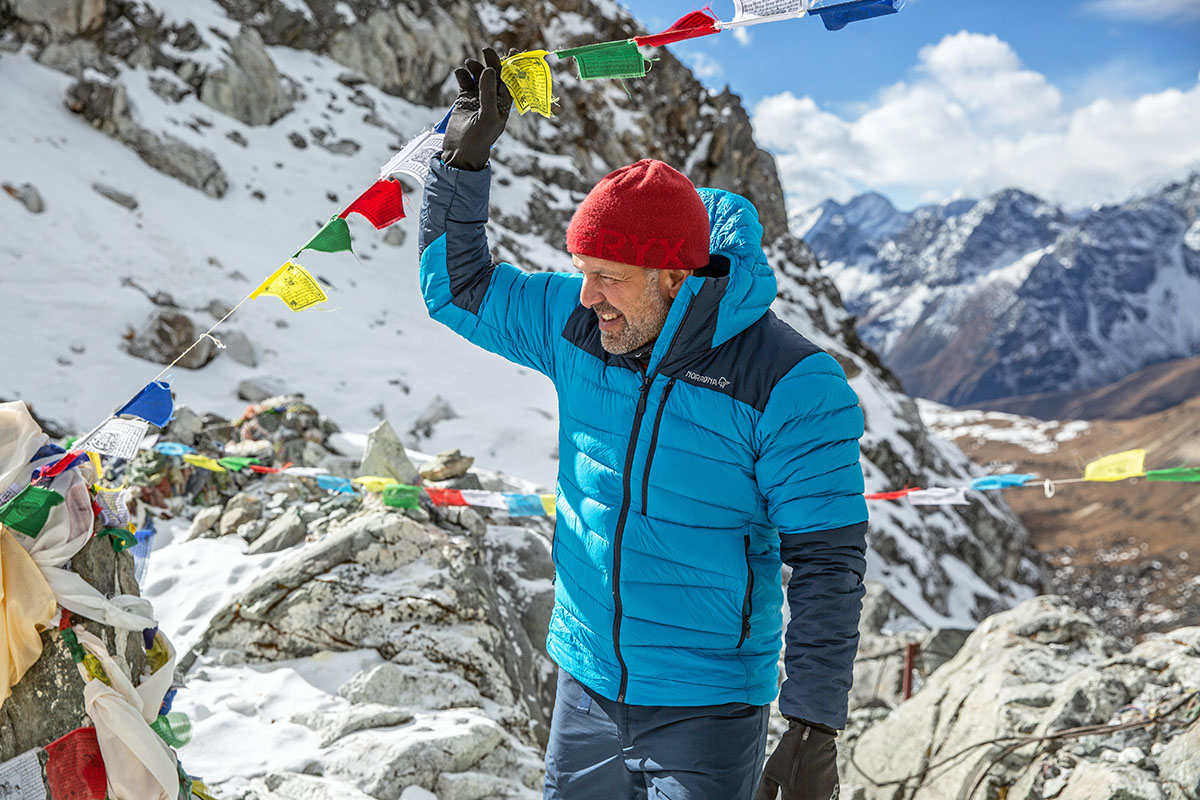
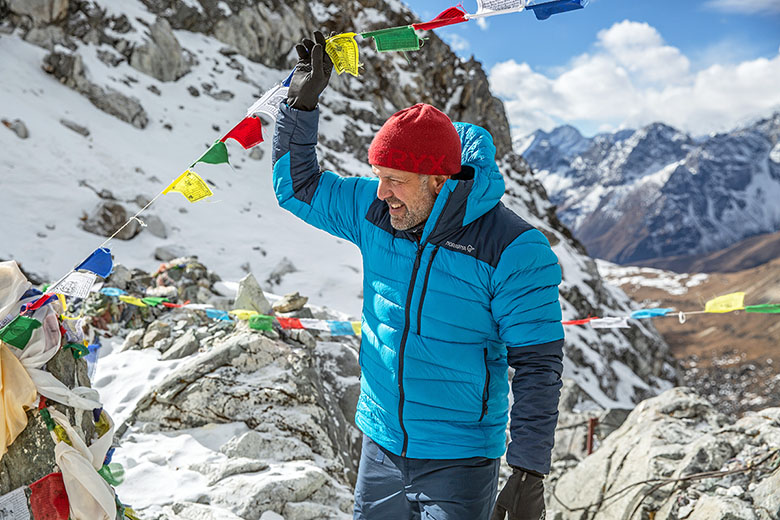
Switchback Travel (Brian McCurdy)
It's tough to beat a great down jacket, whether it’s for casual use or tearing around the backcountry. This cozy insulation type offers the best warmth-to-weight ratio on the market and packs down smaller than synthetics for easy storage. Below are the best down jackets of winter 2024, including leading down sweaters, ultralight models, and winter-weight designs for cold weather. For more background information on warmth, weight, denier and more, see our down jacket comparison table and buying advice below the picks. Note: This article includes picks for both men and women, but our team has also written a dedicated round-up on the best women’s down jackets.
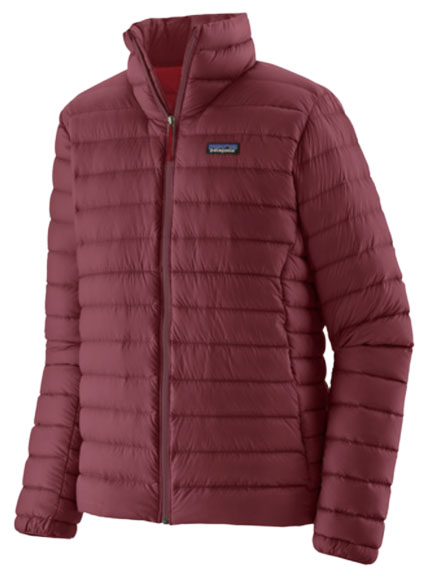 Category: Lightweight
Category: Lightweight
Weight: 13 oz.
Fill: 5.0 oz. of 800-fill down
What we like: Extremely versatile, looks great, and warm for the weight.
What we don't: A bit heavy for backcountry use.
The down jacket market ranges from performance to casual and everything in between, but you won’t find a more versatile option than the Patagonia Down Sweater. With 5 ounces of 800-fill-power down, the jacket is light and packable enough for backpacking and travel yet offers enough warmth to use as a midlayer for skiing. In addition, it looks great for everyday use—few outdoor companies can match Patagonia in crossover appeal—and is now available in eight sizes from XXS to 3XL. And we can't help but love the build quality. Of all of the brands we've tested, Patagonia jackets consistently last longer and end up winning us over with their longevity.
The Down Sweater was recently redesigned, and highlights include an all-new NetPlus shell (made from recycled fishing nets), significantly more down insulation (5 oz. compared to the previous version’s 3.4 oz.), and drop-in pockets for additional storage. We’re big fans of all of the updates, but the latest model does cost $50 more than its predecessor. And at 13 ounces (just 0.1 oz. lighter than the prior version), it's still far from an ultralight backcountry piece. Finally, the fit isn’t as tailored as some of the performance designs on this list, although the upside is that you can layer either over top or underneath, which isn't the case with most technical pieces. All told, for a highly versatile down jacket that can play the part for winter commuting, summertime camping, and everything in between, the Patagonia Down Sweater remains hard to beat... Read in-depth review
See the Men's Patagonia Down Sweater See the Women's Patagonia Down Sweater
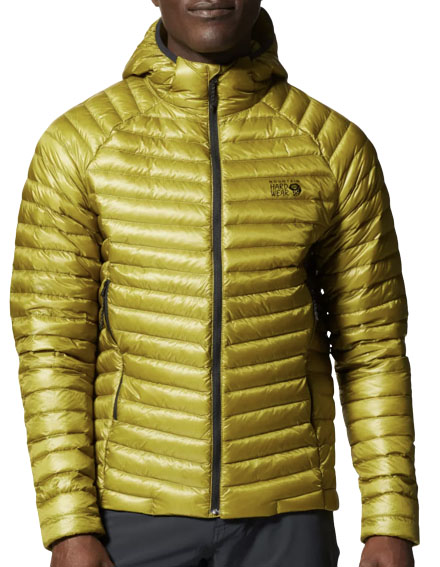 Category: Ultralight
Category: Ultralight
Weight: 8.8 oz.
Fill: 3.0 oz. of 800-fill down
What we like: Incredible warmth for the weight and good feature set.
What we don’t: Fit is a bit boxy; non-elasticized cuffs don’t do a great job at sealing out the cold.
A couple seasons ago, Mountain Hardwear revamped one of the original ultralight down jackets: its popular Ghost Whisperer. Now the “2,” the latest model features a small increase in weight (about 1 oz. for the men’s hoody) but comes with a number of notable upgrades. To start, there’s a little more 800-fill down stuffed inside, and the recycled shell is a bit thicker, which translate to modest increases in warmth and durability. But the jacket stays true to its roots with excellent packability and a simply phenomenal warmth-to-weight ratio, while including important features like zippered hand pockets, a hem adjustment, and decent wind and water resistance. For fast-and-light missions, the Ghost Whisperer/2 remains a go-to choice.
Unfortunately, two elements that have not changed with the Ghost Whisperer/2 are its fit and cuff design. Unlike the tailored cut that you get from Arc’teryx Cerium or Feathered Friends Eos, the Mountain Hardwear is boxy and awkwardly large in the torso. It still layers reasonably well under a shell, but we’re surprised they haven’t given it a better performance fit considering its intended use. Further, the cuffs are loose and don’t provide a very solid seal, which can let cold air sneak through unless you throw on a pair of gloves. Despite these nitpicks, the rebooted Ghost Whisperer is very light, warm, and a favorite among serious outdoor adventurers... Read in-depth review
See the Men's MH Ghost Whisperer See the Women's MH Ghost Whisperer
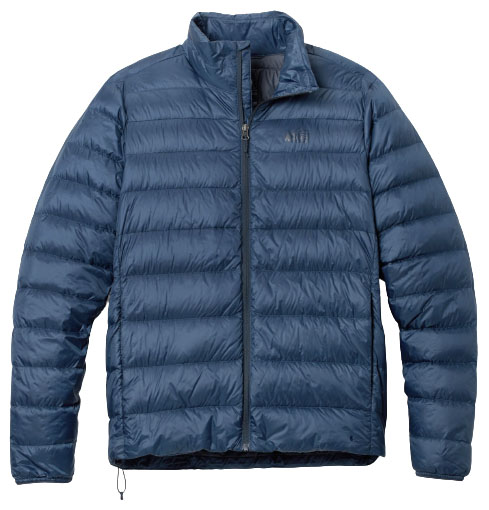 Category: Lightweight
Category: Lightweight
Weight: 10.9 oz.
Fill: 4.2 oz. of 650-fill down
What we like: Fantastic price for a well-rounded, lightweight design.
What we don’t: Not particularly compressible and doesn’t come with an included stuff pocket or sack.
REI’s 650 Down Jacket has been our top budget pick for years, and the most recent update sticks to the winning formula. The jacket is reasonably light at 10.9 ounces (our men's size small is even less at 10.2 oz.), provides solid warmth with over 4 ounces of 650-fill-power down, and features a windproof and water-resistant shell. REI also honed the design with the latest version by adding a hem adjustment, a more durable ripstop nylon shell, and traditional horizontal baffles (the previous version had box baffles). The price did go up by $29, but so did the quality, and the jacket still easily undercuts most competitors by $150 or more. For daily use, travel, light adventuring, and as a midlayer for resort skiing, you simply won’t find a better deal.
Budget-oriented products almost always come with compromises, and REI’s down jacket does fall short for serious performance use. The 650-fill down isn’t quite as warm or compressible as the 800-fill of the Patagonia Down Sweater above, and the most recent version no longer packs into its hand pocket (nor does it include a stuff sack). What’s more, the fit is fairly roomy, which is great for casual use but less ideal for sliding under a trim-fitting hardshell. But circling back to value, the 650 Down Jacket’s combination of warmth, build quality, and price are simply unmatched, making it an indisputable “yes” for those on a budget. REI leads the outdoor industry in inclusive sizing, too: The men’s jacket comes in 10 sizes, including four “Tall” sizes, while the women’s version is available in eight sizes from XS to 3X.
See the Men's REI 650 Down Jacket See the Women's REI 650 Down Jacket
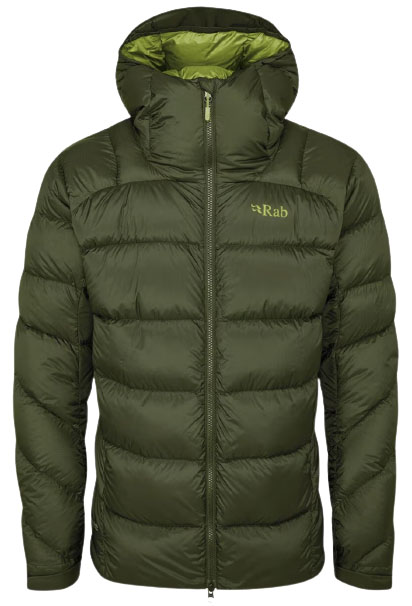 Category: Heavyweight
Category: Heavyweight
Weight: 1 lb. 5.3 oz.
Fill: 7.5 oz. of 800-fill down
What we like: Tons of premium down at a reasonable price point.
What we don’t: Heavy and bulky; not versatile for year-round use.
For cold-weather climbing, frigid nights of winter camping, or as an extra layer during ski transitions, there’s no match for the security of a heavyweight down jacket. These jackets are epitomized by their sleeping-bag-like loft, tall and protective collars, and longer cut. Because they’re meant to be worn as an outer layer (you’d be hard-pressed to squeeze a hardshell overtop such a lofty piece), heavyweight down jackets also feature a durable, water-resistant shell and handy extras like internal stash pockets, which are great for storing skins or keeping your climbing shoes warm. It doesn’t get much better for all-out warmth, and our current favorite is the Rab Neutrino Pro.
One of the most noteworthy features of the Neutrino Pro is its Pertex Quantum Pro shell, which is impressively hardwearing and weather resistant despite its thin, lightweight build. This tough exterior makes the Rab fully capable as a belay jacket or outer layer in below-freezing conditions, although we wouldn’t test its limits in a rainstorm. And with 7.5 ounces of 800-fill-power down (for the men’s medium), you get about twice the warmth of most jackets here, which is a steal considering the Neutrino Pro’s $385 price tag. It’s true that the Neutrino Pro is undeniably heavy and bulky, and its chart-topping warmth means it’s not a versatile piece for summer hiking or backpacking. But for sleeping-bag-like loft and warmth on a cold winter day, it fits the bill... Read in-depth review
See the Men's Rab Neutrino Pro See the Women's Rab Neutrino Pro
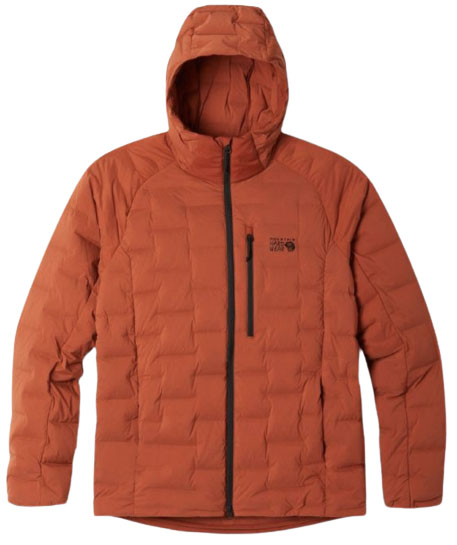 Category: Light/midweight
Category: Light/midweight
Weight: 1 lb. 4.5 oz.
Fill: 4.3 oz. of 700-fill down
What we like: Super comfortable and one of the best-looking jackets on this list.
What we don’t: Pricey for a casual piece.
Mountain Hardwear launched its Stretchdown line a handful of years ago, epitomized by soft and stretchy shells and welded seams (rather than stitched baffles). The goal here was to combine the insulation of down with the range of motion, durability, and comfort of a softshell—and we’d say Mountain Hardwear pulled it off pretty well. The jacket’s knit fabric is very tough, and the stretchiness gives it a plush feel that you typically don’t get from a down piece. Tack on some clean styling—even the logo is understated—and the Stretchdown is a practical and good-looking jacket for everyday use.
But the performance chops of the Stretchdown are limited: The 700-fill-power down has less loft than the true backcountry pieces on this list, and the jacket is bulky and heavy for the amount of warmth you get. Further, $300 is no small price for a casual item, especially when you can save $170 with the REI 650 above. Finally, we have noticed that the Stretchdown’s fabric has a tendency to hold stains, and the elastic in our cuffs has grown tired over time. But we have a soft spot for this jacket (no pun intended), which receives compliments almost every time we go out. It’s also worth noting that Mountain Hardwear offers a number of versions of the Stretchdown, including a heavyweight parka (one of our tester’s go-to jackets for everyday winter use).
See the Men's Mountain Hardwear Stretchdown See the Women's Mountain Hardwear Stretchdown
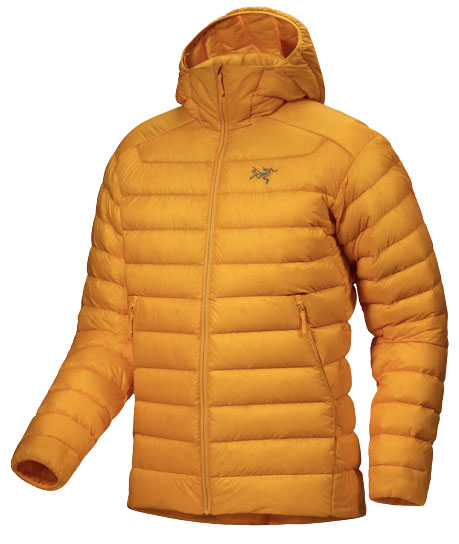 Category: Lightweight
Category: Lightweight
Weight: 11.9 oz.
Fill: 4.0 oz. of 850-fill down; 80g & 100g Coreloft
What we like: Serious performance chops; premium look and feel.
What we don’t: Expensive; not as light as the outgoing version.
Oh, the beauty of Arc’teryx products. They generally cost the most, look the best, and perform well enough for seasoned adventurers to put them through the wringer on a consistent basis. Replacing the Cerium LT Hoody in their lineup this year, the Cerium Hoody is the company’s leading lightweight down jacket and one sleek piece of gear. With a total weight of 11.9 ounces, a nearly complete feature set, a silky interior and exterior, and a very clean design overall, the Cerium plays and looks the part. We also like the use of Down Composite Mapping, which includes synthetic insulation in areas prone to getting wet. While most jackets on this list are strictly down, Arc’teryx has created a really nice balance of lightweight warmth and functionality.
The most common knock against Arc’teryx products is price. At $400, the Cerium is a full $130 more than our top-ranked Down Sweater (or $70 more than the hooded version), which will get the job done for all but the most discerning users. But the new version improves upon some of our biggest gripes with the outgoing model, including an updated fit with more room in the midsection, a thicker (15D vs. 10D) nylon face fabric, and more eco-friendly materials. It also features a reverse-coil front zipper with a TPU pull (rather than a thin cord) for sleeker looks and operation. All told, the Cerium is an exceptionally well-built piece of gear, looks great (we frequently get compliments when wearing it around town), and can more than handle its own in the backcountry... Read in-depth review
See the Men's Arc'teryx Cerium Hoody See the Women's Arc'teryx Cerium Hoody
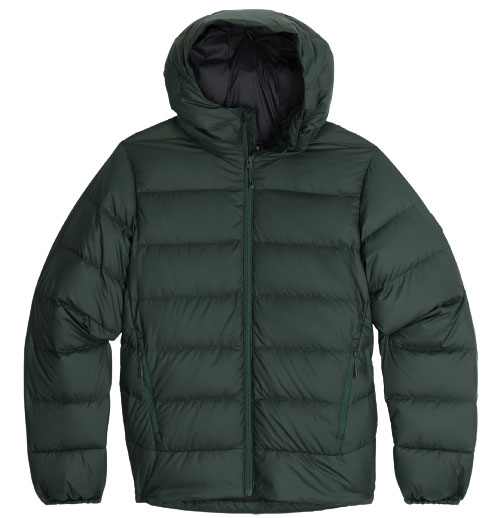 Category: Midweight
Category: Midweight
Weight: 1 lb. 4.7 oz.
Fill: 6.7 oz. of 700-fill down & 150g VerticalX ECO
What we like: Comfy, classy, and well-priced for what you get.
What we don’t: Doesn’t pack down nearly as small as more premium options.
Outdoor Research jackets aren’t always the highest-quality or most technical on the market, but they are some of the best values. The Coldfront Down Hoodie carries the torch: At $279, it’s a considerable step down in price from the more premium options on this list but doesn’t fall too far behind in terms of performance. Warmth is quite impressive with 6.7 ounces of 700-fill down, plus you get more weather-ready VerticalX ECO synthetic insulation at the shoulders and cuffs. We also love the soft-yet-rugged shell and nice touches like fleece-lined handwarmer pockets, snug-fitting cuff gaiters with thumb loops, and classy branding on the sleeve. For everyday use and casual winter adventuring, the Coldfront is a very well-rounded option.
With mid-range 700-fill down, a hefty dose of synthetic insulation, and a relatively durable (30D) shell, the Coldfront is not a particularly lightweight option. In fact, at 1 pound 4.7 ounces, it’s well over twice as heavy as the ultralight Ghost Whisperer above. Outdoor Research did streamline the design with the newly released Coldfront LT Down Hoodie ($249), which features thinner baffles and just 4.9 ounces of 700-fill-power down. But while it’s advertised as OR’s lightest and most packable down jacket, the LT is still relatively hefty at 1 pound 2.1 ounces and can’t compete with the true UL pieces here. In the end, OR’s Coldfront offerings aren’t our first choice for the backcountry, but they’re undeniably high on value and offer great durability for everyday use.
See the Men's Outdoor Research Coldfront See the Women's Outdoor Research Coldfront
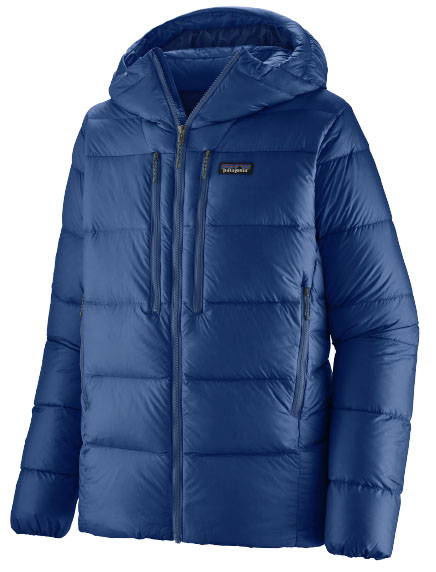 Category: Midweight
Category: Midweight
Weight: 1 lb. 1.1 oz.
Fill: 5.6 oz. of 800-fill down
What we like: A technically savvy jacket for fast-and-light winter objectives.
What we don’t: Expensive; not as warm or protective as heavyweight options.
Patagonia’s Down Sweater is a versatile jacket for both casual and performance use, but their Fitz Roy Down Hoody steps it up a notch for serious climbers and skiers. There’s not a huge difference in warmth between the two models (the Fitz Roy uses 5.6 oz. of 800-fill down, while the hooded version of the Down Sweater has 5.3 oz.), but that’s about where the similarities end. The Fitz Roy uses a Pertex Quantum shell for a boost in durability and weather protection and tacks on a climbing helmet-compatible hood, draft collar, and two zippered chest pockets. It’s also almost 2 inches longer for added coverage under—or over—a harness. The net result is a highly effective insulator for speedy winter missions when you demand a lot from your jacket and every ounce counts.
Despite the Fitz Roy’s lofty, sleeping bag-like design, it’s not technically a heavyweight jacket. For reference, the Rab Neutrino Pro above contains considerably more insulation (7.5 oz. of 800-fill down) while offering more coverage down the back (the Rab’s center back length is 30.3 in. compared to the Patagonia’s 29 in.). But the Rab is prohibitively heavy for fast-and-light endeavors, while the Patagonia strikes a better balance of weight, protection, and features (although we do wish it had a two-way zipper). If you’re in the market for a belay parka or a light-but-warm insulator for ski tours, the Fitz Roy is a high-performance design from a brand known for quality... Read in-depth review
See the Men's Patagonia Fitz Roy
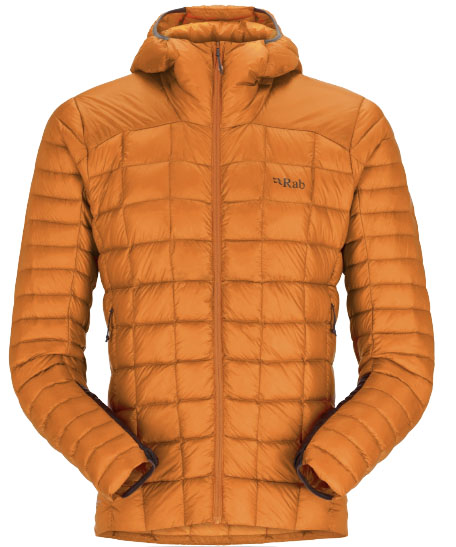 Category: Ultralight
Category: Ultralight
Weight: 8.8 oz.
Fill: 2.8 oz. of 900-fill down & PrimaLoft Gold
What we like: A great price for a very premium ultralight jacket.
What we don’t: Thin shell is too fragile for everyday use.
Rab’s Mythic Alpine Light is a relatively new entry on our list, giving the Mountain Hardwear Ghost Whisperer a run for its money as our top ultralight pick. We haven’t stopped singing the jacket’s praises since we first tested it last year. It’s incredibly premium considering the price point, touting 900-fill down and PrimaLoft Gold insulation along with a protective and durable Pertex Quantum shell. And at just 8.8 ounces, it’s an excellent option for those looking to maximize warmth for the weight. But the Mythic Alpine Light is not all function—it’s also a great-looking piece with boxed baffles and a small but classy colorway selection, and we love the flattering length that offers a bit of extra coverage down the back.
If you’re considering the Ghost Whisperer above, don’t overlook the Mythic Alpine Light. For $30 less, the Rab checks in at the same weight and features more premium down (900 vs. 800-fill-power), along with synthetic insulation at the sides, cuffs, shoulders, and hood for added breathability and weather protection. What’s more, it’s over an inch longer than the Mountain Hardwear, which we love for standalone use—although the Mythic might peek out from underneath the hem of a minimalist rain jacket or hardshell. All told, there’s a lot to like about Rab’s ultralight jacket, especially for those who venture out in wet climates or changing mountain conditions. And for a bit more warmth, Rab also makes the standard Mythic Alpine, which features 2.1 ounces more down for an additional $60.
See the Men's Rab Mythic Alpine Light See the Women's Rab Mythic Alpine Light
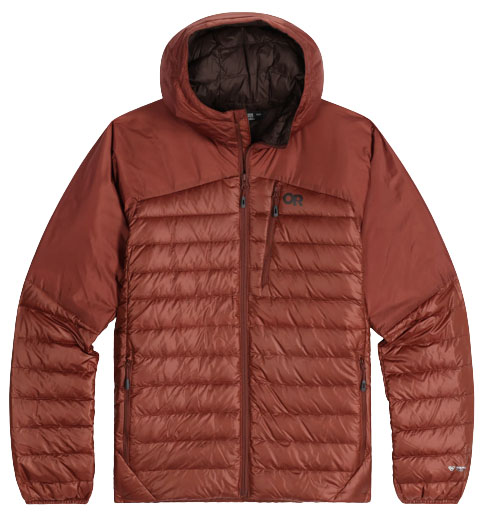 Category: Lightweight
Category: Lightweight
Weight: 15.4 oz.
Fill: 3.9 oz. of 800-fill down
What we like: Waterproof fabric on the hood and shoulders; particularly abrasion resistant.
What we don’t: Shell is fairly crinkly; heavy for a performance-oriented jacket.
For all their inherent strengths, down jackets aren’t perfect: Namely, they perform poorly in wet weather and their thin fabrics are often lacking in durability. But with the Helium Down Hoodie, Outdoor Research addresses both of these concerns in one fell swoop. The Helium uses Pertex’s Diamond Fuse technology throughout the shell, which improves abrasion resistance without adding weight. On top of that, you get waterproof Pertex Shield—the same fabric used in OR’s popular Helium Rain jacket—on the hood and shoulders for protection from rain and melting snow. The result is a sub-1-pound down jacket that is both impressively durable and relatively capable in wet weather.
But while the Helium Down’s partially waterproof shell is a nice touch, you won’t find us relying on it for much more than a light rain or snow. In terms of the competition, the Cerium Hoody above is significantly lighter, and the use of synthetic Coreloft in the hood and shoulders (which insulates even when wet) lends similar wet-weather assurance. In addition, we’ve found the crinkly Diamond Fuse shell makes the OR jacket a little less cozy than an alternative like the Cerium, and the jacket is known to run small for its size. Nitpicks aside, the Helium’s solid weatherproofing and durability make it an intriguing standalone piece, earning it a spot on our list.
See the Men's Outdoor Research Helium Down See the Women's OR Helium Down
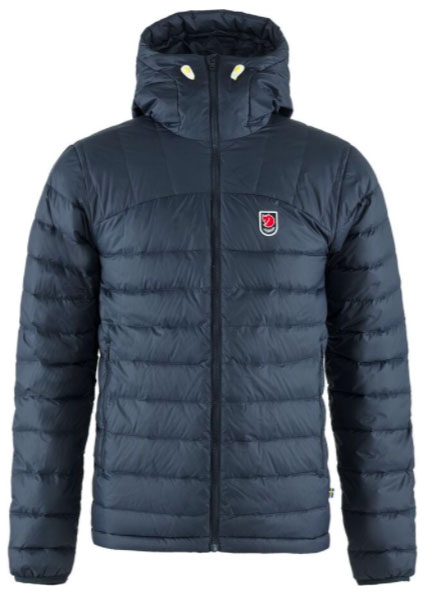 Category: Light/midweight
Category: Light/midweight
Weight: 1 lb. 1.3 oz.
Fill: 3.9 oz. of 700-fill down & synthetic
What we like: High-end look and feel; athletic fit.
What we don’t: Heavier than the lightweight competition.
Swedish brand Fjallraven does a nice job of marrying premium design with performance, as evidenced by their Expedition Pack down jacket. We’ll start by noting that you don’t get the 800-fill-power down or higher that brands like Arc’teryx or Patagonia offer, but for casual use and done-in-a-day adventures, it’s a quality option. The jacket has a healthy amount of 700-fill down for warmth, synthetic insulation in the shoulders for extra weather resistance and toughness, a terrific hood, and an athletic fit that is less baggy than many options on this list. All in all, we like the premium looks and versatility of the Expedition Pack.
In terms of competitors, the Fjallraven offers a similar level of warmth as of our top picks like the Patagonia Down Sweater and Arc’teryx Cerium above, but it’s not quite as light or packable, limiting its backcountry appeal. This said, we appreciate the durability of Fjallraven products in general, and the synthetic insulation in the shoulders makes wearing a pack for extended periods more feasible (it’s a nice option for hiking and snowshoeing). And there’s no denying the Expedition Pack’s coziness, attention to detail, and good looks, which are a testament to the brand’s overall expertise. Finally, for those interested in using the Expedition Pack as a midlayer, Fjallraven makes a non-hooded version for $260... Read in-depth review
See the Men's Fjallraven Expedition Pack See the Women's Expedition Pack
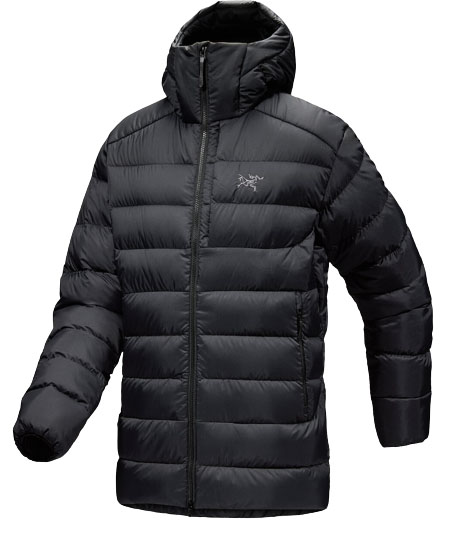 Category: Midweight
Category: Midweight
Weight: 1 lb. 2.2 oz.
Fill: 5.2 oz. of 750-fill down; 80g & 140g Coreloft
What we like: Durable shell fabric and a technically minded feature set.
What we don’t: Expensive; not a warmth-to-weight leader.
The Arc’teryx Cerium Hoody above is a lightweight backcountry piece with a thin 15-denier shell, and that doesn’t come without sacrifices. For a bit less of a specialized down jacket from Arc’teryx, the recently updated Thorium Hoody (previously the Thorium AR) is considerably more durable (30D) and warmer with more down and synthetic fill (although it uses 750-fill-power down instead of 850). For all types of outdoor activities including winter use and everyday wear around town, the Thorium arguably is the more versatile option and one that you won’t have to worry about as much.
The most recent iteration of the Thorium includes a number of new performance-oriented features, including a helmet-compatible hood, two internal dump pockets, and a two-way main zip. These are great additions for activities like cold-weather cragging or ski touring, bringing the Thorium into the same category as technical pieces like the Patagonia Fitz Roy and Rab Neutrino Pro. On the other hand, the Arc’teryx is no match for these designs in terms of warmth to weight (both use more premium down and thinner face fabrics), giving us pause in recommending it for weight- or space-conscious missions. But if you’re willing to make the $500 investment, the Thorium Hoody is nevertheless a premium down jacket, and its robust shell fabric will hold up to everyday use and abuse better than most... Read in-depth review
See the Men's Arc'teryx Thorium Hoody See the Women's Arc'teryx Thorium Hoody
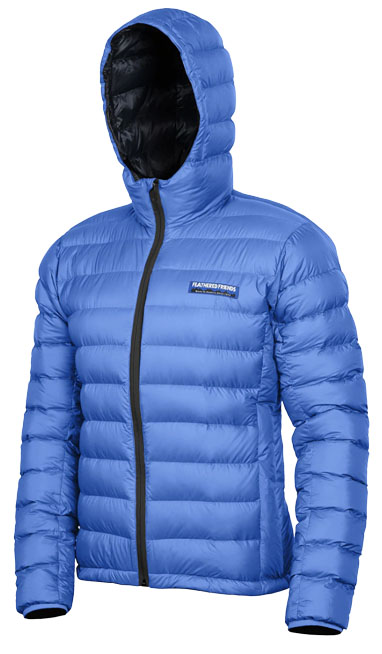 Category: Ultralight
Category: Ultralight
Weight: 10.8 oz.
Fill: 3.7 oz. of 900-fill down
What we like: Superb build quality and warmth-to-weight ratio.
What we don’t: Expensive and unflattering fit.
Feathered Friends doesn’t do splashy marketing campaigns like other gear brands, but this down specialist gets a whole lot of respect among the alpine community (if you’re in Seattle, the store is across from the REI flagship and makes for a fun visit). Here’s what you get from Feathered Friends: premium construction (including some of the highest-fill-power down on the market), local manufacturing in Seattle or Vancouver, and a decently competitive price given that they only sell their products in-house. Their performance-oriented lineup of jackets ranges from lightweight designs to heavyweight expedition-grade parkas, and the Eos stands out as the most approachable option for the masses. With an impressive 3.7 ounces of 900-fill down in a 10.8-ounce build, it offers more warmth for the weight than just about any jacket here.
Why isn’t the Eos ranked higher? For one, Feathered Friends is more of a down specialist than a fashion company, and the jacket has a boxy, unflattering fit that isn’t quite as appealing for daily wear as competitors like the Arc’teryx Cerium or Patagonia Down Sweater above. Second, the jacket is pricey at $409, which puts it in the same price range as much warmer offerings like the Rab Neutrino Pro and Patagonia Fitz Roy. A final consideration is availability: There can often be a delay before the jacket ships out, and—unless you live in Seattle—you won’t be able to try it on before you buy. But if you’re not put off by those downsides, the Eos is one of the highest-performing down jackets on the market for weight-conscious climbers, skiers, and more... Read in-depth review
See the Men's Feathered Friends Eos See the Women's Feathered Friends Eos
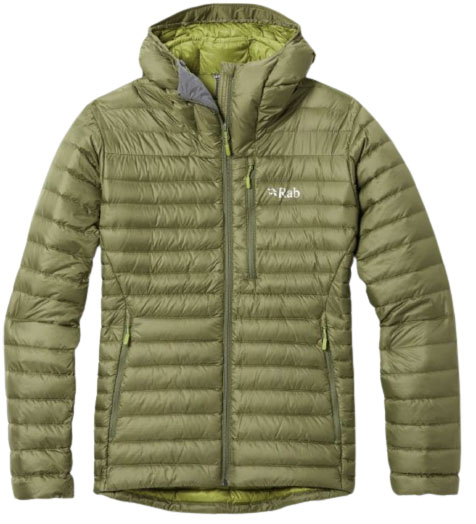 Category: Lightweight
Category: Lightweight
Weight: 1 lb. 0.5 oz.
Fill: 5.4 oz. of 700-fill down
What we like: A nice level of warmth with a water-resistant build.
What we don’t: A tad heavy for the backcountry.
Rab’s popular Microlight Alpine Jacket pays tribute to the brand’s climbing heritage. To start, it's built to handle wind and light moisture thanks to a tough Pertex Quantum shell, DWR coating, and hydrophobic down. Further, we found the rigid structure of the jacket’s wire-brimmed hood has a hardshell-like feel, offering great all-around coverage and protection. You’ll still want to don a waterproof layer if the skies open up, but the Microlight Alpine stands out as one of the more weather-resistant midweight down jackets we’ve tested.
The Rab has been a long-time favorite among casual users and serious alpinists alike, but it's up against some stiff competition. The OR Helium Down above offers more weather protection with fully waterproof fabric across the shoulders and hood, and the chart-topping Patagonia Down Sweater users higher-quality down while clocking in at a lighter weight (14.8 oz. for the hooded version). But for those who want the best of both worlds, the Rab offers a great combination of warmth and weather resistance—and the price is really reasonable at just $295... Read in-depth review
See the Men's Rab Microlight Alpine See the Women's Rab Microlight Alpine
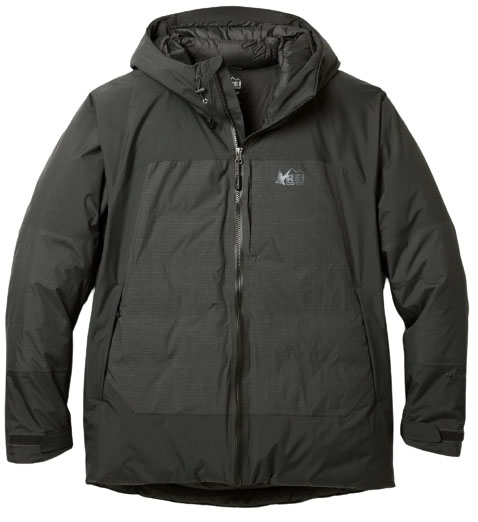 Category: Heavyweight
Category: Heavyweight
Weight: 1 lb. 15.8 oz.
Fill: 850-fill down; 180g & 80g polyester
What we like: Fully waterproof and very warm.
What we don’t: Pretty heavy and bulky.
REI isn’t known for pushing the boundaries of jacket design, but we really like what they’ve come up with in the Stormhenge Down Hybrid. The Stormhenge stands out with its fully waterproof 2-layer shell (a rarity in the down jacket world), meaning you get the protection of a rain jacket alongside the lofty warmth of a down insulator. The jacket also features nice touches like pit zips, two internal dump pockets, and a sleeping bag-like draft tube at the neck. Unfortunately, REI does not provide the fill weight, but with a significant dose of premium 850-fill down, the Stormhenge nevertheless is one of the warmest options on this list.
The Stormhenge’s unique waterproof construction helps it stand out among other foul weather-ready down jackets like the Rab Neutrino Pro above. Both models have DWR treatments that cause water to bead up and roll off of the shell, but without a waterproof membrane, the Rab falls well short of the REI in consistently wet conditions. However, the Stormhenge is the heaviest performance-focused jacket on the list at almost 2 pounds and doesn’t pack down very small. As a result, it lacks versatility for uses like backpacking or climbing, but the warm and waterproof build is a great match for everything from cold winter walks to downhill skiing... Read in-depth review
See the Men's REI Stormhenge Down See the Women's REI Stormhenge Down
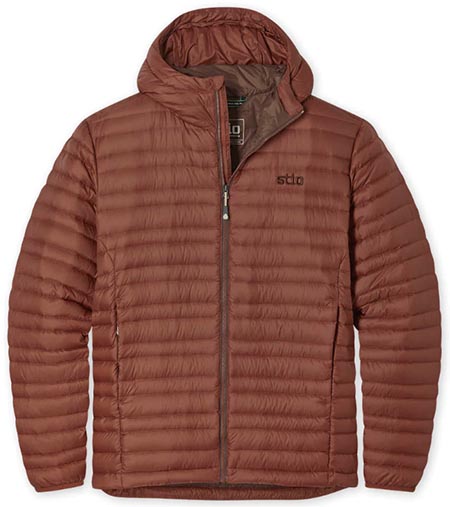 Category: Lightweight
Category: Lightweight
Weight: 12 oz.
Fill: 3.3 oz. of 800-fill down
What we like: High-quality down, Pertex Quantum shell, and clean-looking design at a good price.
What we don’t: Doesn’t stand out in a competitive field; below-average warmth.
Jackson Hole-based Stio has a strong presence in the Mountain West, but we’re seeing more and more of the brand’s signature pinecone logo throughout the U.S. They have a couple entries in the down jacket space, and our current favorite is the Pinion Down Hooded. In many ways, it reminds us of Patagonia’s discontinued Ultralight Down Jacket: closely spaced baffles, premium 800-fill-power down, and a supple ripstop shell. Speaking of the shell, Stio opted for 20-denier Pertex Quantum, which hits a nice balance of toughness, packability, and weather resistance. And the hoody has good sustainability chops, too, with recycled fabrics, a PFC-free DWR coating, and a bluesign certification.
With an MSRP of $285, the Stio Pinion goes head-to-head with a number of our longtime favorites. In terms of build and material quality, the jacket holds up nicely: The large-toothed center zipper has a premium feel, the three-pocket layout is perfect for use as a mid-or outer layer, and we’ve had zero durability issues to date. Where the Pinion comes up a little short, however, is warmth. With 3.3 ounces of 800-fill down in the hooded version, you get far less insulation than Patagonia’s popular Down Sweater Hoody (5.3 oz. of 800-fill down). Nor are you getting class-leading weight—at 12.9 ounces for our men’s small, it’s about average. In the end, there’s plenty to like about the Stio, but the fact that it doesn’t manage to stick out in any specific way leads to a lower-half finish. One final fit-related note: We found it runs a little big and opted to size down since we’re often on the fence.
See the Mens Stio Pinion Hooded See the Women's Stio Pinion Hooded
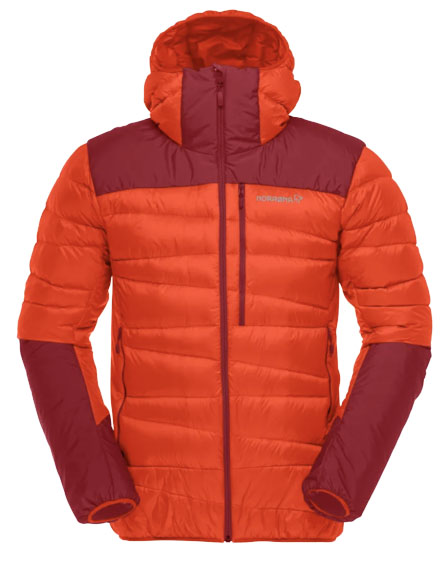 Category: Lightweight
Category: Lightweight
Weight: 15.7 oz.
Fill: 3.5 oz. of 750-fill down; synthetic
What we like: Thoughtful design boosts weather resistance and durability.
What we don’t: A little heavy for backcountry use, limited storage.
Norrøna might not be on everyone’s radar, but the Norwegian company has a serious lineup of outerwear built for performance use. Their Falketind Down750 is a lightweight down jacket that has served us well both as a cold-weather midlayer (worn underneath a hardshell) and standalone piece in milder conditions. A number of features set it apart from other jackets here, including body-mapped insulation—the down fill is centered largely around the core, while synthetic fill is used in exposed areas for added durability and weather protection—and fabric reinforcements (45D) at the shoulders and lower arms for abrasion resistance. We wore the Falketind Down750 for a winter of travel (including a 16-day trek in Nepal and backcountry skiing in BC), and it proved itself a capable companion in fall and winter conditions.
That said, we do have a few minor gripes with the Falketind Down750’s design. First off, both of our handwarmer pockets have stitching on the inside that reduces the usable area by a sizable margin (we undid the stitches in one pocket but our handiwork resulted in a damaged zipper). Second, the jacket lacks interior storage (we appreciate dump pockets for storing skins or climbing shoes), and the hand pockets’ low placement makes them inaccessible under our backpack’s hip belt. Finally, the Norrøna is heavier than much of the lightweight competition (you can get comparable warmth for almost 5 oz. less with the Eos above), although many will consider this a fair trade for the added water resistance and durability. Added up, the Falketind Down750 is a hardwearing and thoughtfully designed down jacket with the top-notch build quality we’ve come to expect from Norrøna... Read in-depth review
See the Men's Norrøna Falketind Down750 See the Women's Norrøna Falketind Down750
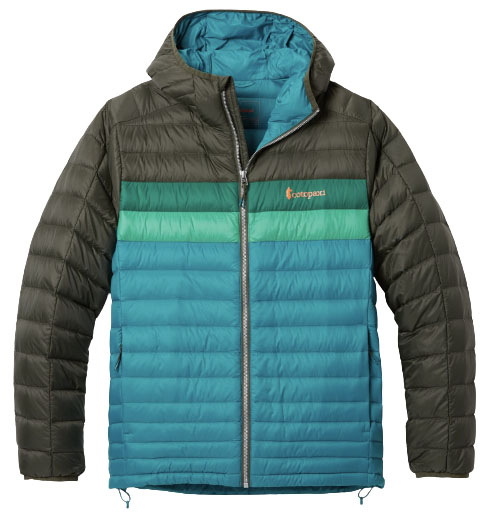 Category: Lightweight
Category: Lightweight
Weight: 14 oz.
Fill: 800-fill down
What we like: Retro styling with premium down fill.
What we don’t: Materials aren't very soft; not everyone likes the striped colorways.
Many down jacket brands keep their styling fairly close to the cuff, but Cotopaxi stands out with its fun, retro designs. The Utah brand’s leading down jacket is the Fuego, which gets you premium 800-fill down (we were unable to track down the fill weight from the company), along with a versatile 20-denier shell that is reasonably tough while keep weight down. Of course, the retro styling is what stands out most and Cotopaxi currently is offering the jacket in nine colorways, all but one with the signature multi-colored baffles on the front. Throw in responsibly sourced down and the fact that Cotopaxi is a certified B Corp, and the Fuego is an easy jacket to get behind.
In terms of competitors, Patagonia’s Down Sweater Hoody uses the same 800-fill down but is almost 1 ounce heavier and costs $329 (without fill weight, it’s difficult to make a more exacting comparison). But the specs don't offer a full picture here. The biggest reason we rank the Cotopaxi here is quality: The Fuego has a noticeably plasticky and slippery feel, especially when held up against pricier options like the Patagonia, and its fit is boxy and unflattering. But the Cotopaxi nevertheless hits a nice balance of performance chops, casual appeal, and value, which is why we've included it on our list... Read in-depth review
See the Men's Cotopaxi Fuego See the Women's Cotopaxi Fuego
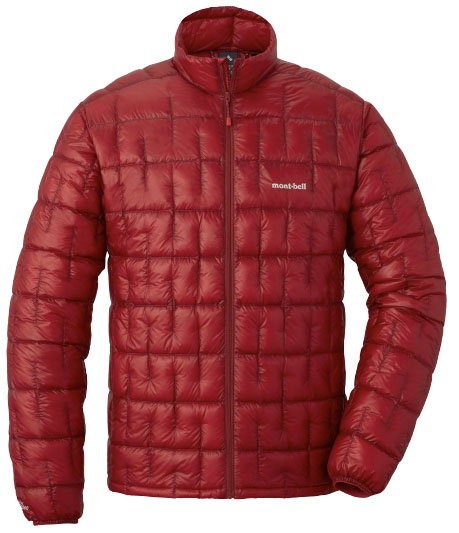 Category: Ultralight
Category: Ultralight
Weight: 4.9 oz.
Fill: 1.6 oz. of 1,000-fill down
What we like: Incredible warmth-to-weight ratio—the best on the market.
What we don't: Super thin shell fabric is lacking in durability.
Among serious alpinists, you won’t find an outdoor brand with more street cred than Montbell. This Japan-based company makes gear for those who depend on it, and doesn’t spend much on paid athletes or splashy marketing campaigns. But the proof is in the pudding: Montbell makes some of the most well-respected ultralight insulation on the market, and their most unique offering is the Plasma 1000. With ultra-premium 1,000-fill-power down (that is not a misprint) along with a paper-thin 7-denier shell, it’s by far the lightest down jacket on this list at an incredible 4.9 ounces all-in.
Why isn’t the Montbell Plasma 1000 ranked higher? First, the 1.6 ounces of down fill is pretty meager—it may work for warm-weather backpacking on a route like the Appalachian Trail, but on its own, may not provide enough insulation even for summer nights in the mountains. Second, the 7-denier shell is extremely thin and requires extra care to prevent holes and snags. Last but not least, the fit of the jacket felt quite short on us. It’s listed as having a 27-inch length down the center back, but certainly didn’t feel that way in person (the medium was way too short while the large was too baggy). Nevertheless, the Plasma is an impressive technological feat, and for the right person, a fun jacket to have in your quiver.
See the Men's Montbell Plasma 1000 See the Women's Montbell Plasma 1000
| Jacket | Price | Weight | Category | Fill Power |
Fill Weight |
Denier | Packable |
|---|---|---|---|---|---|---|---|
| Patagonia Down Sweater | $279 | 13 oz. | Lightweight | 800 | 5.0 oz. | 20D | |
| MH Ghost Whisperer/2 | $360 | 8.8 oz. | Ultralight | 800 | 3.0 oz. | 10Dx10D | |
| REI Co-op 650 Down Jacket | $129 | 10.9 oz. | Lightweight | 650 | 4.2 oz. | Unavail. | No |
| Rab Neutrino Pro | $385 | 1 lb. 5.3 oz. | Heavyweight | 800 | 7.5 oz. | 20D | Stuff sack |
| MTN Hardwear Stretchdown | $300 | 1 lb. 4.5 oz. | Light/midweight | 700 | 4.3 oz. | Unavail. | No |
| Arc'teryx Cerium Hoody | $400 | 11.9 oz. | Lightweight | 850 | 4.0 oz. | 15D | Stuff sack |
| Outdoor Research Coldfront | $279 | 1 lb. 4.7 oz. | Midweight | 700 | 6.7 oz. | 30D | |
| Patagonia Fitz Roy | $399 | 1 lb. 1.1 oz. | Midweight | 800 | 5.6 oz. | 20D | |
| Rab Mythic Alpine Light | $330 | 8.8 oz. | Ultralight | 900 | 2.8 oz. | 10D | Stuff sack |
| OR Helium Down | $299 | 15.4 oz. | Lighweight | 800 | 3.9 oz. | 15Dx30D | |
| Fjallraven Expedition Pack | $275 | 1 lb. 1.3 oz. | Light/midweight | 700 | 3.9 oz. | Unavail. | |
| Arc'teryx Thorium Hoody | $500 | 1 lb. 2.2 oz. | Midweight | 750 | 5.2 oz. | 30D | Stuff sack |
| Feathered Friends Eos | $409 | 10.8 oz. | Ultralight | 900 | 3.7 oz. | 12Dx20D | Stuff sack |
| Rab Microlight Alpine | $295 | 1 lb. 0.5 oz. | Lightweight | 700 | 5.4 oz. | 30D | Stuff sack |
| REI Stormhenge Down Hybrid | $279 | 1 lb. 15.8 oz. | Heavyweight | 850 | Unavail. | Unavail. | No |
| Stio Pinion Down Hooded | $285 | 12 oz. | Lightweight | 800 | 3.3 oz. | 20D | |
| Norrøna Falketind Down750 | $349 | 15.7 oz. | Lightweight | 750 | 3.5 oz. | 20&45D | |
| Cotopaxi Fuego | $295 | 14 oz. | Lightweight | 800 | Unavail. | 20D | |
| Montbell Plasma 1000 | $369 | 4.9 oz. | Ultralight | 1,000 | 1.6 oz. | 7D | Stuff sack |
Lightweight
The lightweight down jacket category is the industry’s most popular and what most folks are in the market for. Warmth and wearability are top priorities, and you won’t find technical features like helmet-compatible hoods, slim fits, and ultralight shells. But they perform well for everyday use, travel, light adventuring, and layering for winter sports. The temperature range for these jackets depends on factors like layering and exertion, but we find that lightweight models are typically suitable for approximately 35 to 50 degrees Fahrenheit (more on this in “Our Estimated Temperature Scale” below). Leading models include the Patagonia Down Sweater, REI Co-op 650 Down Jacket, and Cotopaxi Fuego.
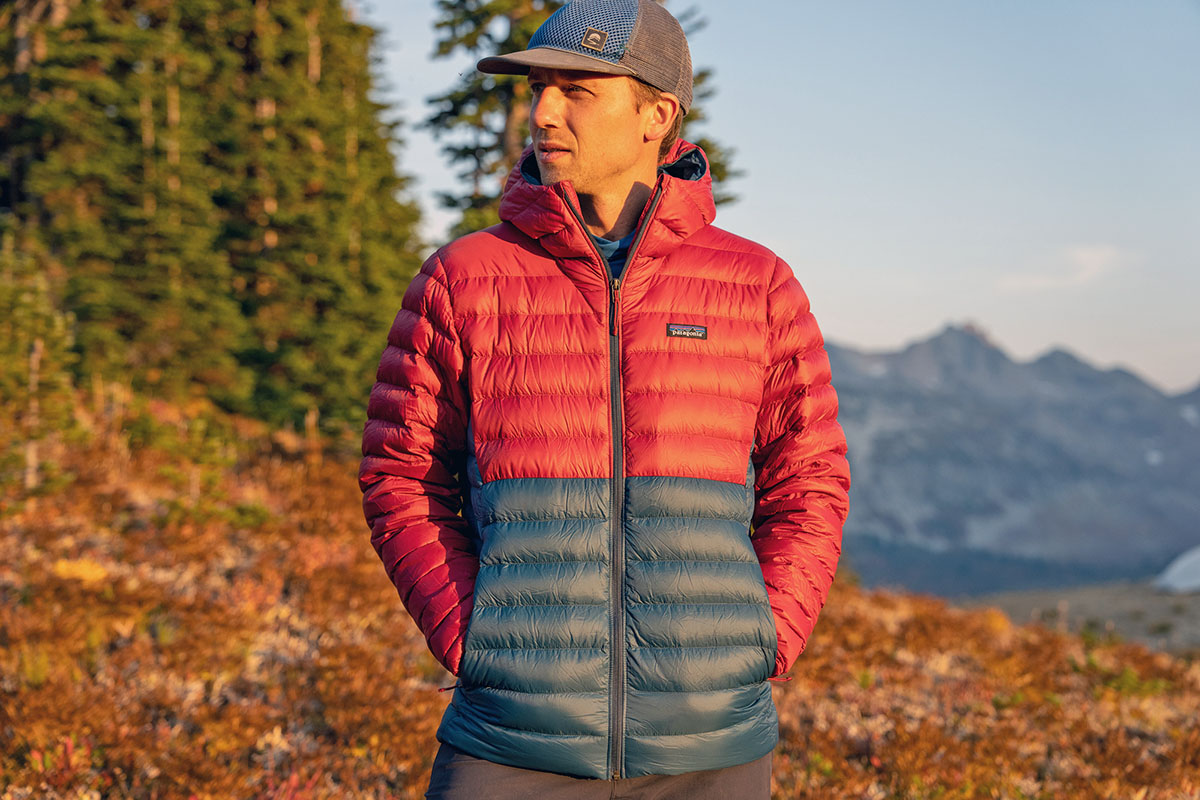
Ultralight
Ultralight down jackets are focused pieces designed for backpacking, climbing, backcountry skiing, and other outdoor pursuits where every ounce matters. These down jackets generally have similar fill weights as lightweight down sweaters, but are ultralight due their use of premium down (fill power), thin shell fabrics (denier), and minimalist zippers and pockets. Interestingly, we frequently see this category of down jacket worn as daily layers around cities, including the Mountain Hardwear Ghost Whisperer/2 and Rab Mythic Alpine Light. They are high-quality jackets in general, and if you are willing to take a little extra care to avoid damaging the shell, they offer a great combination of warmth relative to their weight and athletic fit that's easy to layer.
.jpg)
Midweight and Heavyweight
Down jackets in mid and heavyweight categories represent a significant step up in warmth from lightweight and ultralight models, and are intended for serious winter conditions and uses like alpine climbing and mountaineering. Most notably, you’ll see the fill weights go up from the 3- to 4-ounce range for lightweight jackets to 7.5 ounces (Rab Neutrino Pro) or more for heavy, winter-ready designs. They also are far puffier than the other categories with more down, and as a result take up quite a bit more space in your pack. Because of this, we only bring them along if the extra warmth is absolutely necessary. We’ve included a number of our favorite mid and heavyweight options in this article, but for a deeper dive into the market, see our round-up on the best winter jackets.
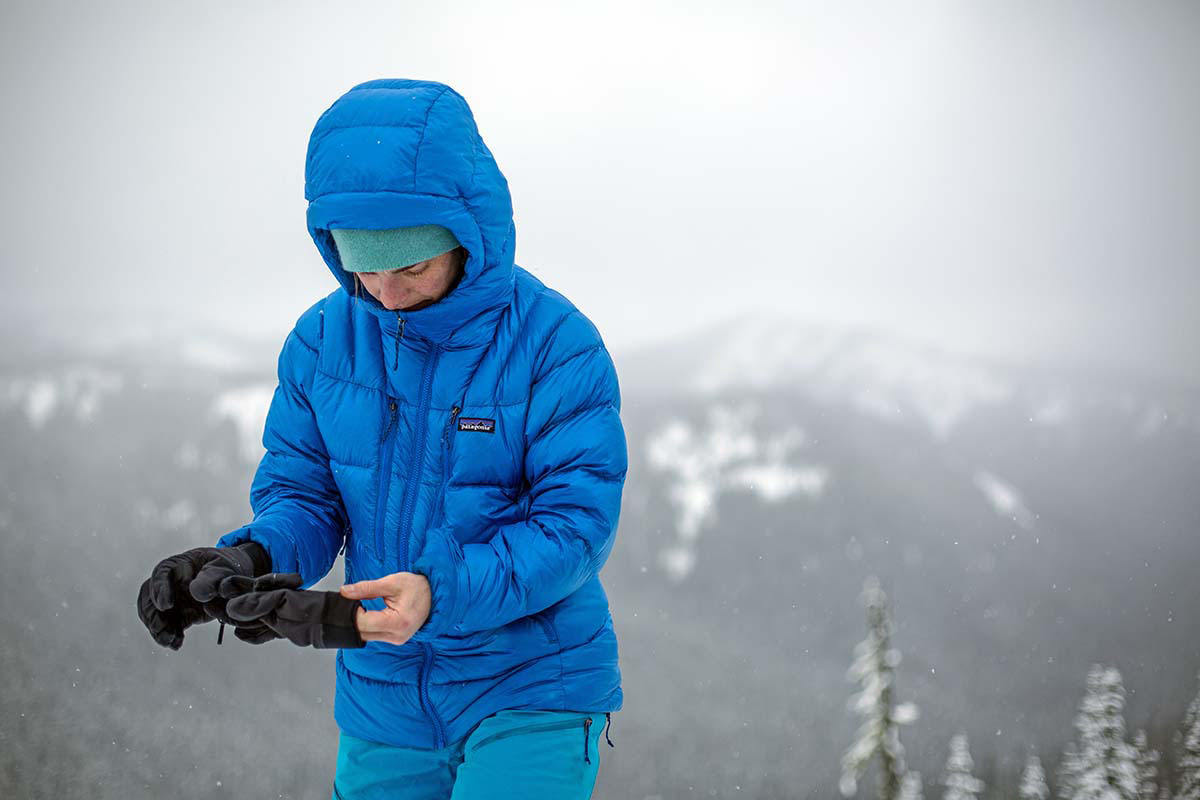
It all starts with that lofty and premium warmth that can only be found in a down-filled product. Down insulation functions so effectively because the loose clusters of feathers are great at trapping body heat. But unlike down sleeping bags, which have an official EN rating system that tests and measures their warmth on a concrete scale, down jackets are more like the Wild West. Below is information that should help you fill in the gaps.
Fill Power
Fill power (600-fill, 700-fill, 800-fill, etc.) is how the quality of down is measured, and the higher the fill the better the down. The number is calculated based on how much space one ounce of down clusters takes up in a cylindrical tube. This is known as the amount of loft, and the more loft a jacket has, the more body heat it traps and the warmer you will be. Put another way, achieving the same amount of warmth with a lower fill power requires more down, adding weight and bulk to achieve the same comfort goals.
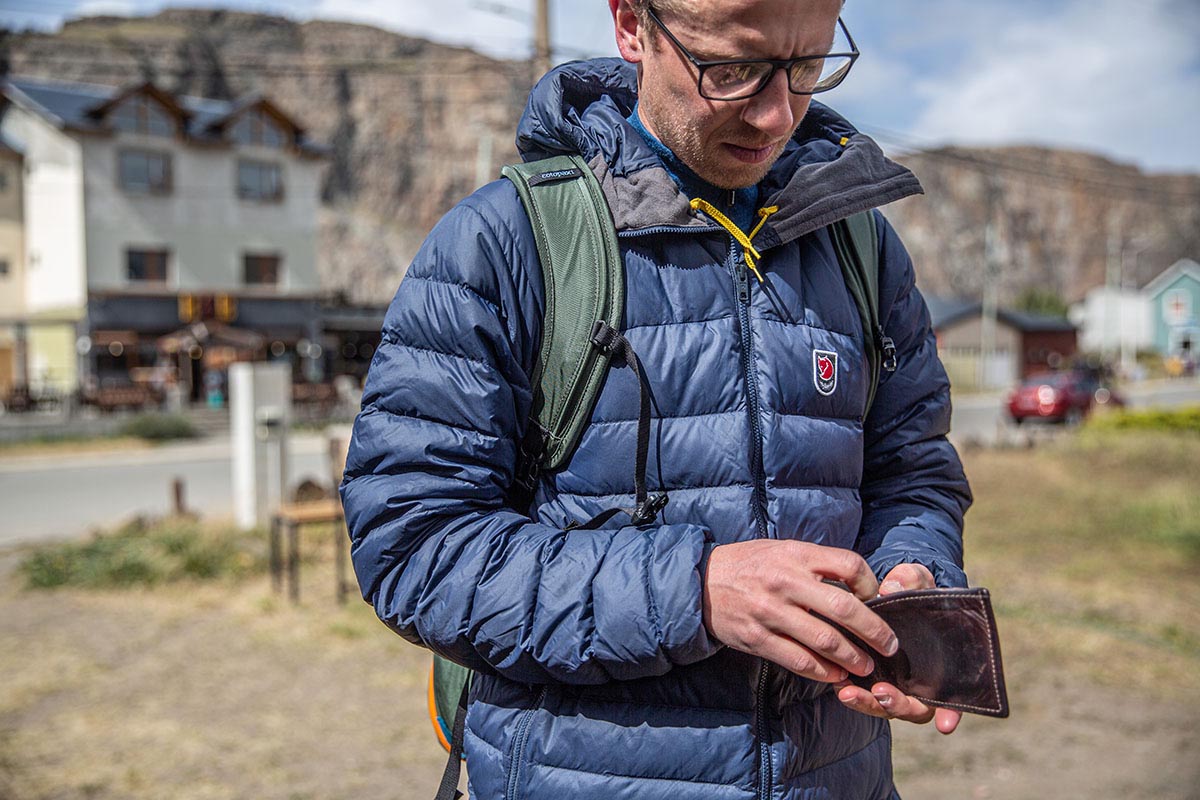
For jackets, 550 to 650-fill down is what you’ll find on most entry and mid-level models, which is perfectly respectable for daily wear but falls short for performance use. Premium down is 800-fill and above, which is what Arc’teryx, Patagonia, and Mountain Hardwear use for their high-end down jackets. At this level of quality, you reap the highly touted benefits of down insulation: lightweight and ultra-compressible warmth. Some high-end climbing brands like Feathered Friends and Montbell use 900-fill down, but that high of a number is a rarity and 800-fill is considered premium. In 2013, Patagonia experimented with a 1,000-fill down jacket, the Encapsil, but hasn’t yet brought it back to market, and Montbell currently offers the 1,000-fill Plasma Down Jacket and Parka with thin 7D shells.
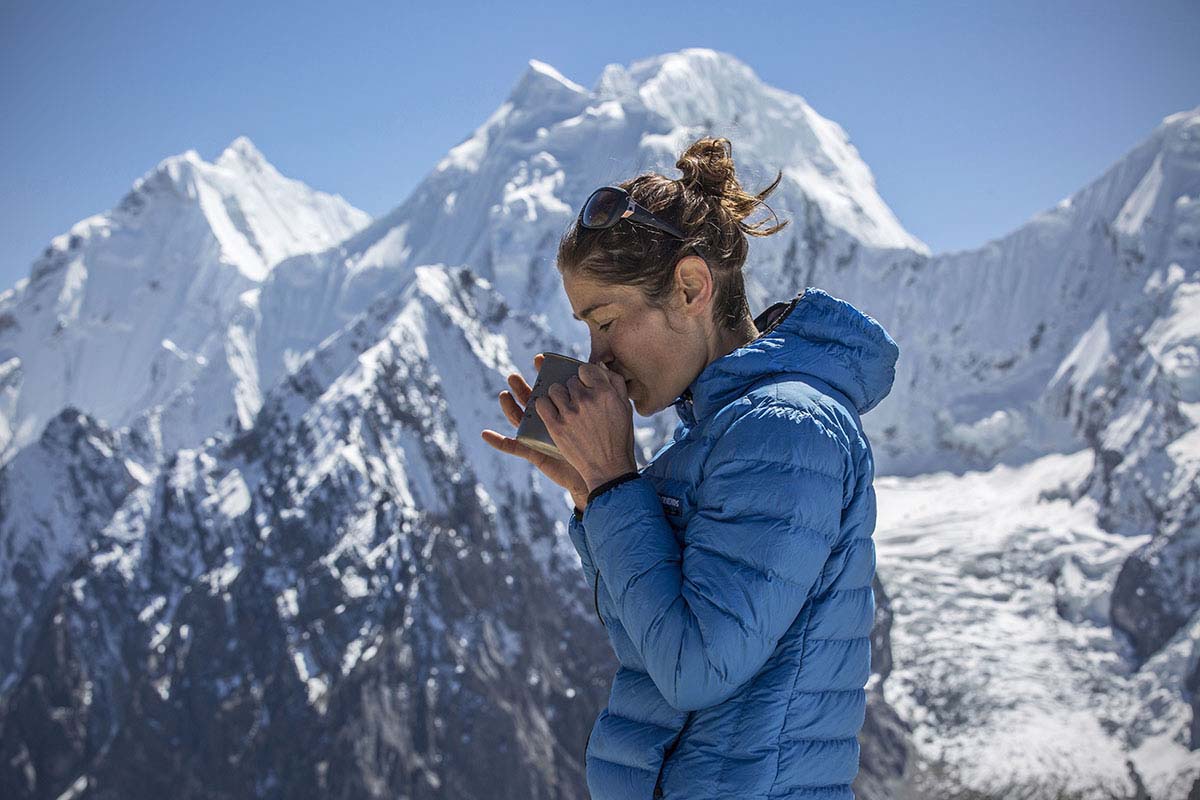
Fill Weight
Fill power gets the most press, but fill weight is perhaps the most important factor in determining a down jacket’s warmth. Fill weight is the actual amount of down stuffed into a jacket, measured in ounces. For example, if Jacket A has 6 ounces of 800-fill down and Jacket B has 3 ounces of 800-fill down, you can expect that Jacket A will be significantly warmer (we estimate that it would increase comfort levels in low output activities by approximately 10-20 degrees). Lower fill power down offers less warmth per ounce, so to compare apples to apples you should use similar fill powers.
.jpg)
We find it interesting that fill weight is much less publicized than fill power, which leads to a lot of confusion for shoppers who associate higher fill power as always meaning more warmth. Apparently the fill power numbers are far sexier, and as a result, we sometimes have to call the manufacturers to track down fill weight as it’s not always listed (for more information, see our article: Down Fill and Insulation Explained).
Our Estimated Temperature Scale
It’s tough to pinpoint an exact temperature range in which you will feel comfortable wearing a down jacket (there’s a reason no one has attempted to create a standardized rating system). Factors like fit, layering, your levels of exertion and circulation, and wind all play a role.
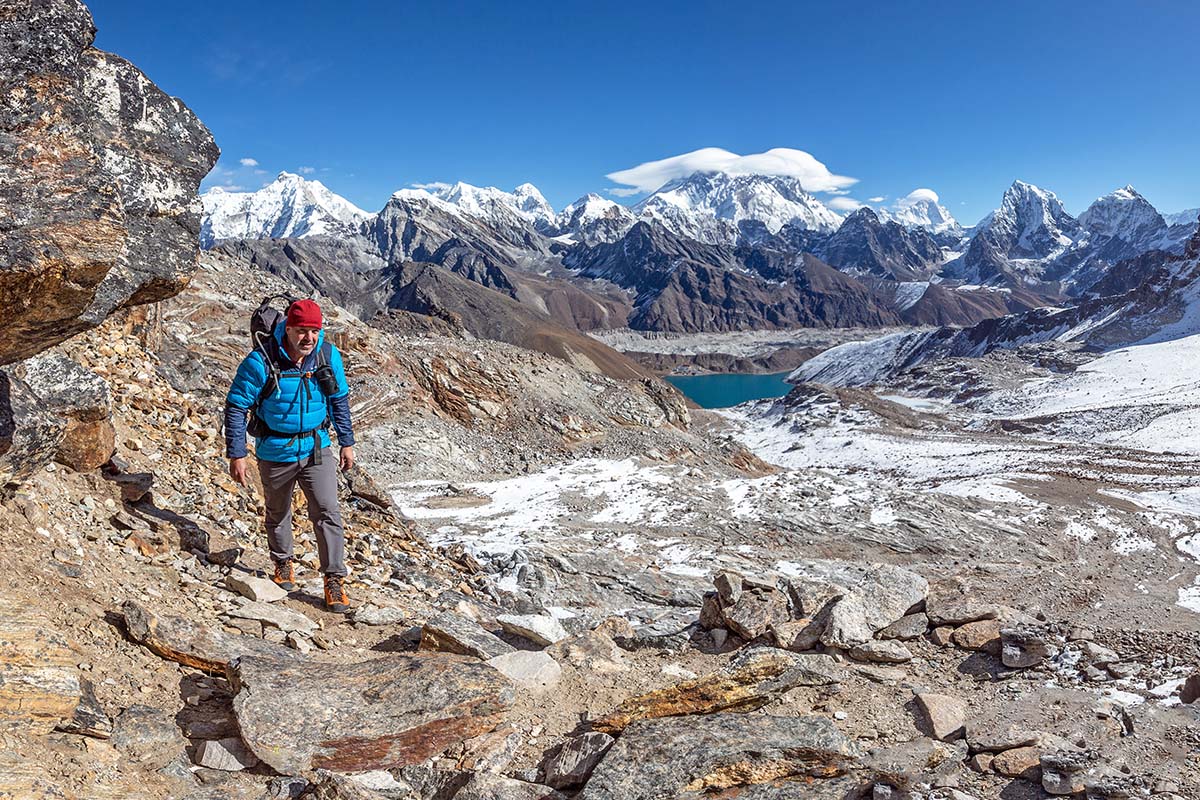
Generally, we think of down sweaters and ultralights—which usually have between 2 and 4 ounces of fill weight—as providing solid warmth in conditions ranging from around 35 to 60 degrees Fahrenheit (2 to 15 degrees Celsius) with low levels of exertion, such as puttering around a campsite. More fill will help you move toward the bottom end of the range and less will push you toward the middle. A cozy baselayer can buy you an extra 5 to 15 degrees depending on its thickness and quality. These types of jackets are very popular for three-season alpine use and in cities for everything but the heart of winter.
When the mercury drops below freezing, you will be more comfortable wearing a true midweight or heavyweight down jacket for winter. The fill weight of these jackets should be 4 ounces at the absolute minimum and often is in the range of 5 to 6 ounces or more (the Rab Neutrino Pro, for instance, has 7.5 oz. of down). For bitter cold and climbing the highest peaks, an even heavier down parka may be in order.
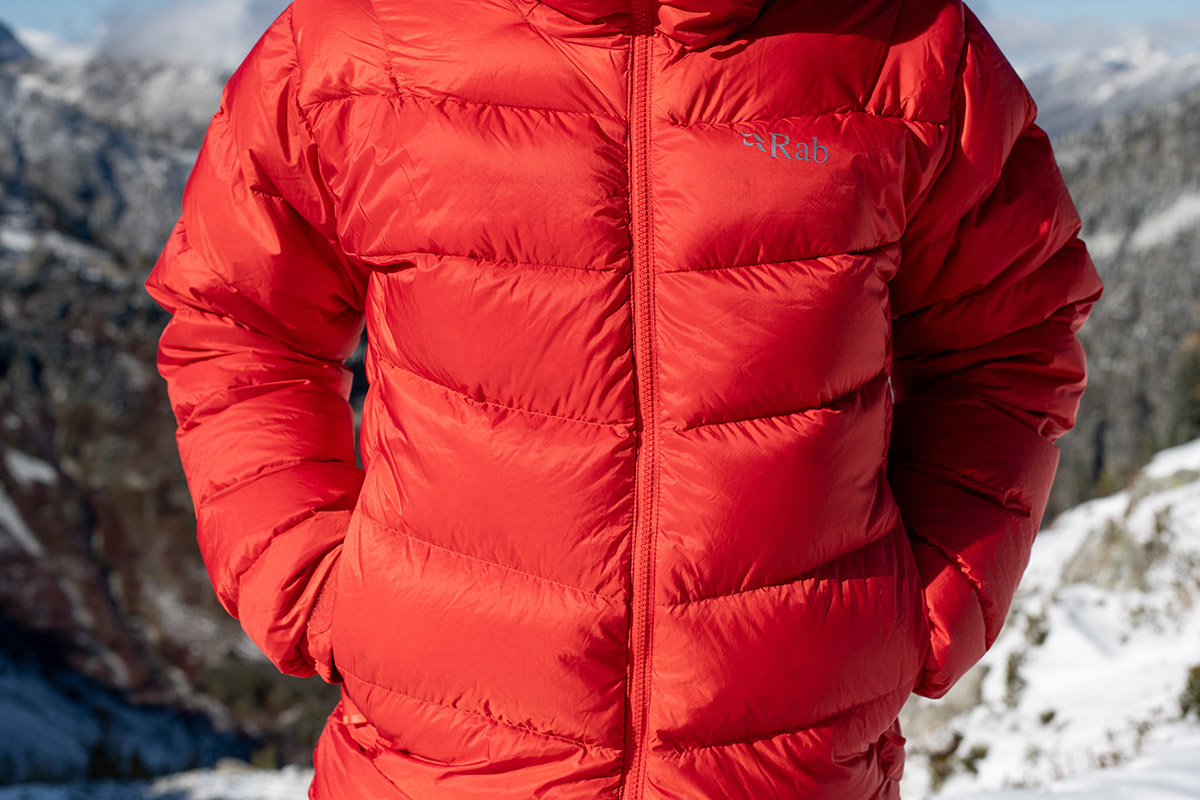
For uses like backpacking, climbing, mountaineering, ski touring, or whenever you have to lug around your own gear, the total weight of your down jacket should play a significant role in your buying decision. Jackets like the Rab Mythic Alpine Light and Mountain Hardwear Ghost Whisperer/2 (both 8.8 oz.) weigh very little for the warmth they provide and compress down extremely small in your pack. As a result of all the fun tech, they also cost considerably more than your typical down sweater. On the other hand, if you just need a layer for around town and occasional outdoor uses like downhill skiing, you'll be completely fine with a somewhat heavier and more affordable build like the 1-pound-4.7-ounce Outdoor Research Coldfront. Finally, winter-ready jackets will obviously be the heaviest options, including the 1-pound-15.8-ounce REI Co-op Stormhenge Hybrid.
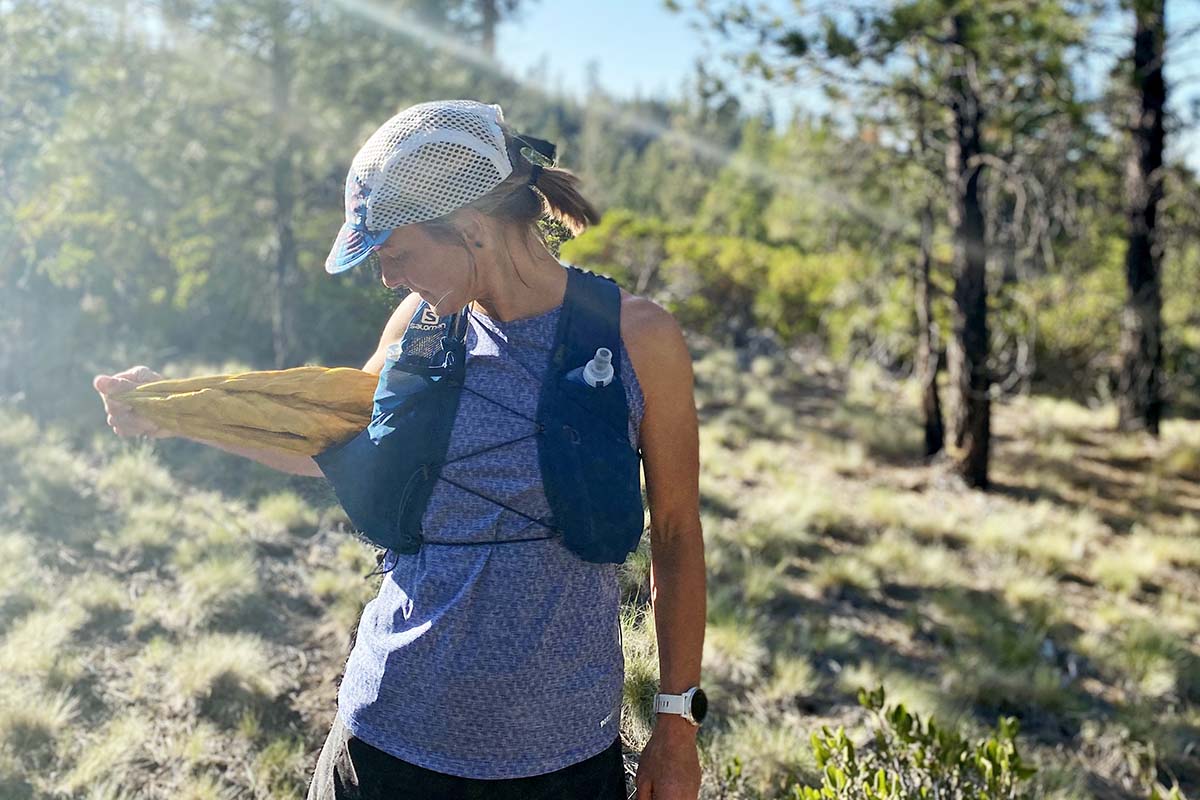
“Ultralight” is a buzzword of sorts that you will inevitably run into when shopping for a down jacket, and it’s worth noting there aren’t hard-and-fast rules as to what qualifies. We keep a close eye on the ratio of fill weight to total weight to see what lengths the manufacturer went to trim weight (the shell denier is a good hint too, and more on that below). At the extreme end of the spectrum is Montbell's Plasma 1000, which packs 1.6 ounces of down inside a super light 4.9-ounce package. When gear companies really prioritize cutting weight, you’ll see changes to zippers, a trim fit, and a lack of pockets. Some even opt for a pullover style to cut out half of the zipper. No matter what the manufacturer names a jacket, keep a close eye on fill weight and total weight to make your own determination.
Denier (D) is the measurement of the weight of a thread, and the lower the number the lighter the weight. A lower denier rating means the material is less durable and more prone to tears or punctures. Much of the difference in weight of an ultralight jacket is trimmed by using a lower denier fabric for the shell. Other factors like premium down (it provides the most warmth for the least amount of weight) and ultralight zippers play a role as well, but the shell fabric is most important.
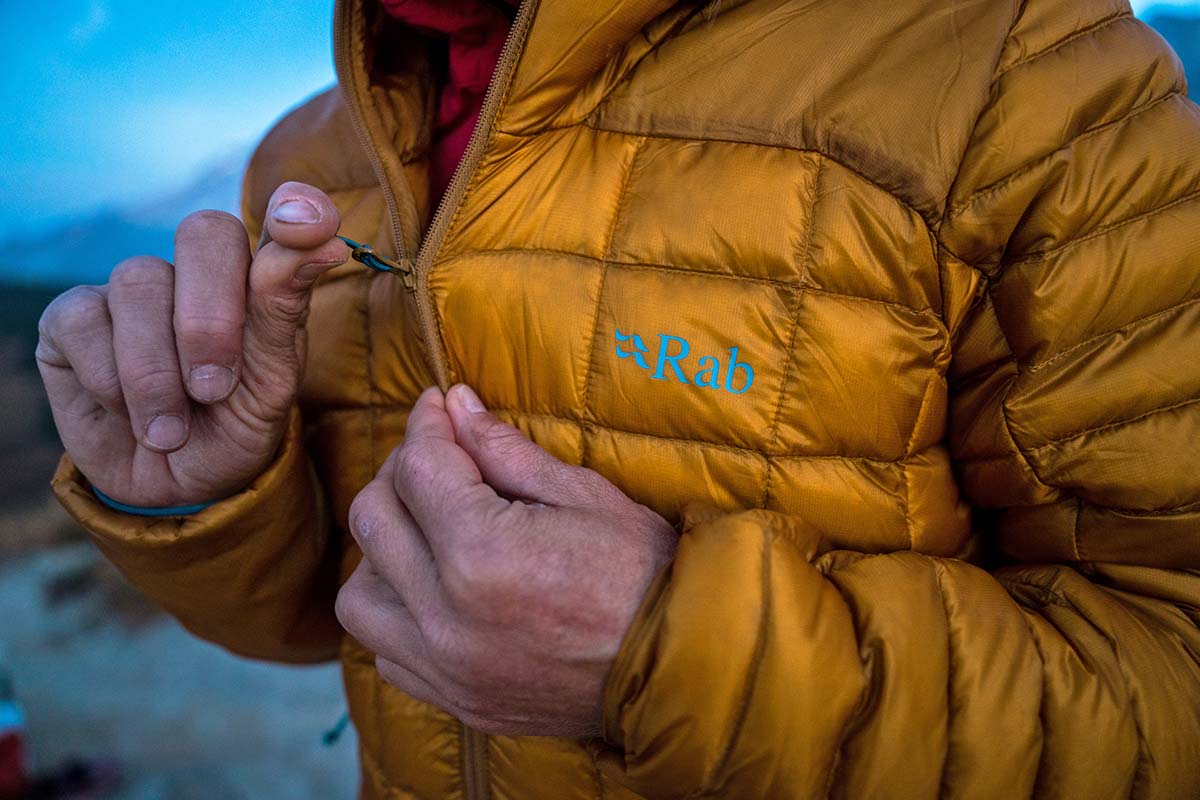
Almost every jacket on this list is made with reasonably lightweight shell fabrics. The thinnest jacket is the Montbell Plasma 1000 , which has a very fragile 7D shell, while some jackets get up to 30D or higher. 10D is pretty standard for ultralights, and a more substantial 20D is what you’ll often find in an average down sweater. Don’t underestimate the importance of denier: even the difference from 10D to 20D can play a significant role in the total weight and potential lifespan of your jacket. If ounces matter and you intend to use the jacket in the backcountry, treat yourself to an ultralight. If most of your use will be in the city, a down sweater is sturdier and should save you money in the process.
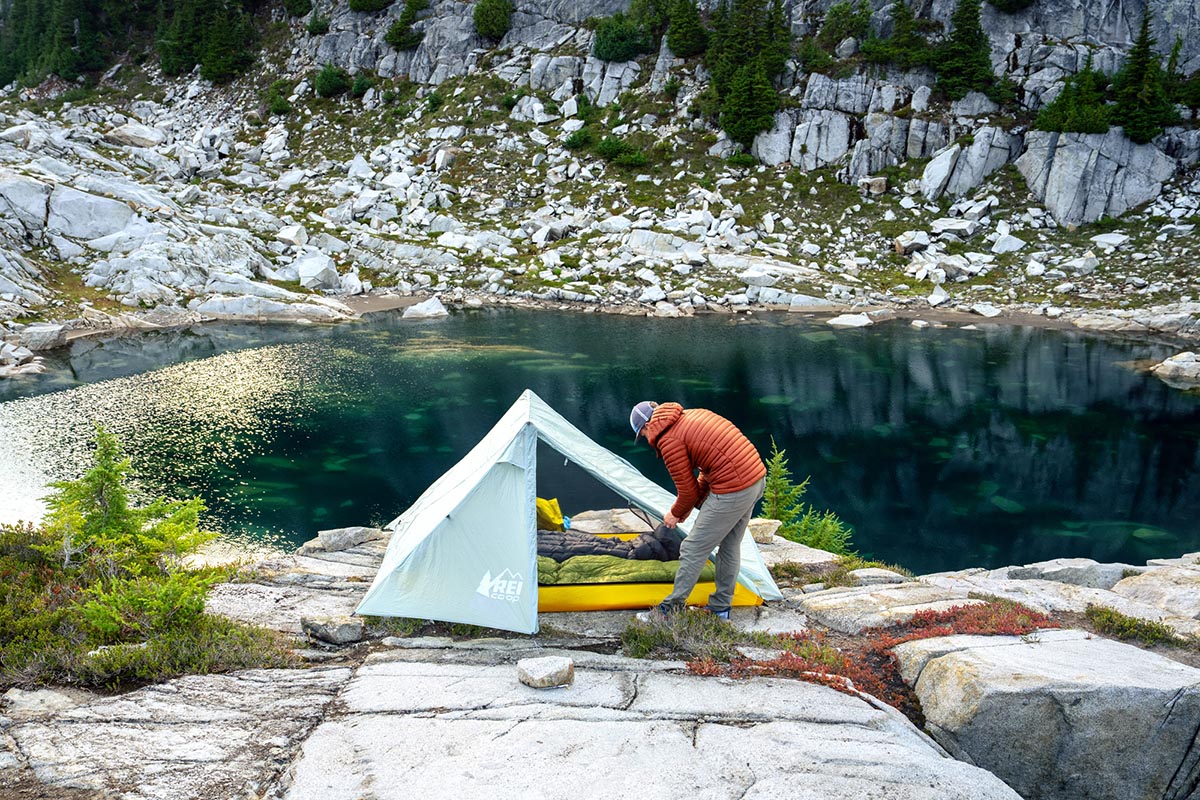
Aside from denier, there are a few more factors to keep in mind when judging a jacket's durability. First off is any technology present in the shell material. Pertex's Quantum Pro (as seen in the Rab Neutrino Pro) is one of our favorite fabric techs, and known to be particularly abrasion resistant—we've tested jackets with 10-denier Quantum Pro shells and found them to be remarkably tough and hard-wearing. Pertex's Diamond Fuse (seen in the OR Helium Down) is also impressive. A second factor is the presence of stretch in the material. Spearheaded by designs like the Mountain Hardwear Stretchdown Hoody, we're seeing more and more down jackets use stretch-woven shells, which lend comfort, mobility, and a good deal of tear resistance.
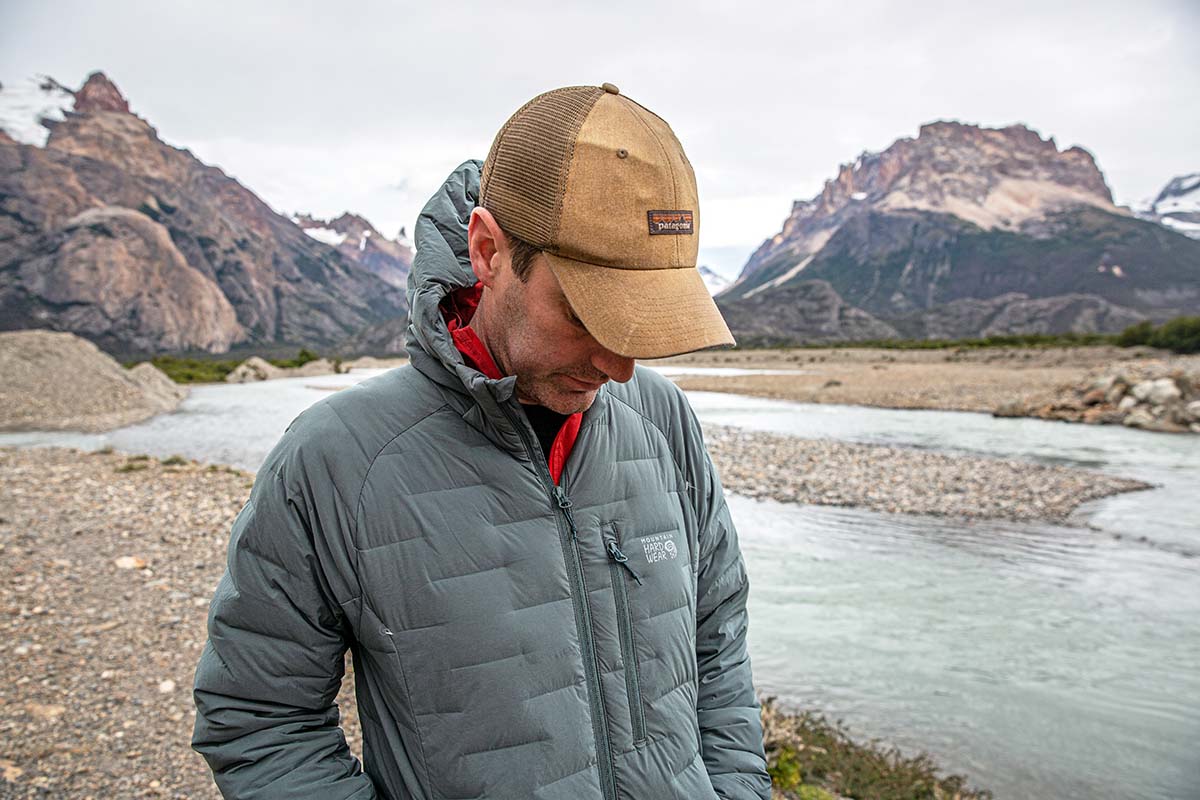
Down enthusiasts love its compressibility and for good reason. An ultralight jacket like the Mountain Hardwear Ghost Whisperer/2 can be stuffed into its own pocket and end up much smaller than a Nalgene bottle. The tiny packed size means you have little reason to leave it behind, and can fit it easily into either a daypack or overnight backpacking pack.
Keep in mind that the higher the fill power the more easily it will compress. This is noticeable when you get into premium levels of down (800-fill and above), which pack down to seemingly impossible sizes yet bounce back after only a few minutes out of the bag (as long as you don’t store it compressed too long). Fabric thickness also plays an important role, and thinner denier fabrics logically pack down smaller. Along with warmth for the weight, compressibility is an area where down dominates the vast majority of synthetic-insulated jackets.
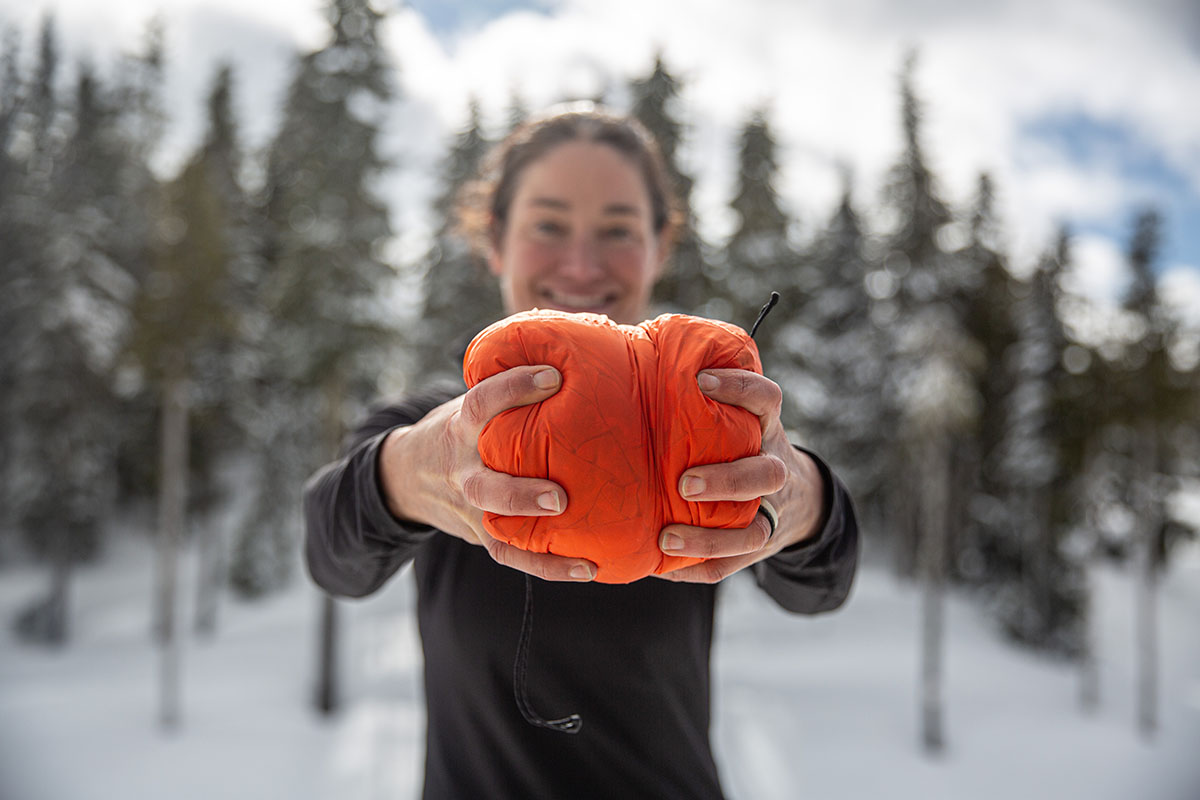
Down feathers unfortunately lose much of their ability to insulate when wet, turning into a clumpy and soggy mess. This makes them a serious liability in wet conditions or if you’re sweating heavily, which is why some prefer a synthetic jacket that continues to insulate when wet.
Nowadays, a lot of gear manufacturers treat down to make it more water resistant. They do this by adding a polymer to the down before filling the jacket, and the result is that it resists water better and you don’t have to worry as much about light precipitation. Even though it still doesn’t match the wet weather performance of synthetics, we love the hydrophobic down movement. If you’re headed out in a wet area like the Pacific Northwest or New Zealand, a jacket with hydrophobic down like the Ghost Whisperer/2 (and a waterproof shell) is a smart choice.
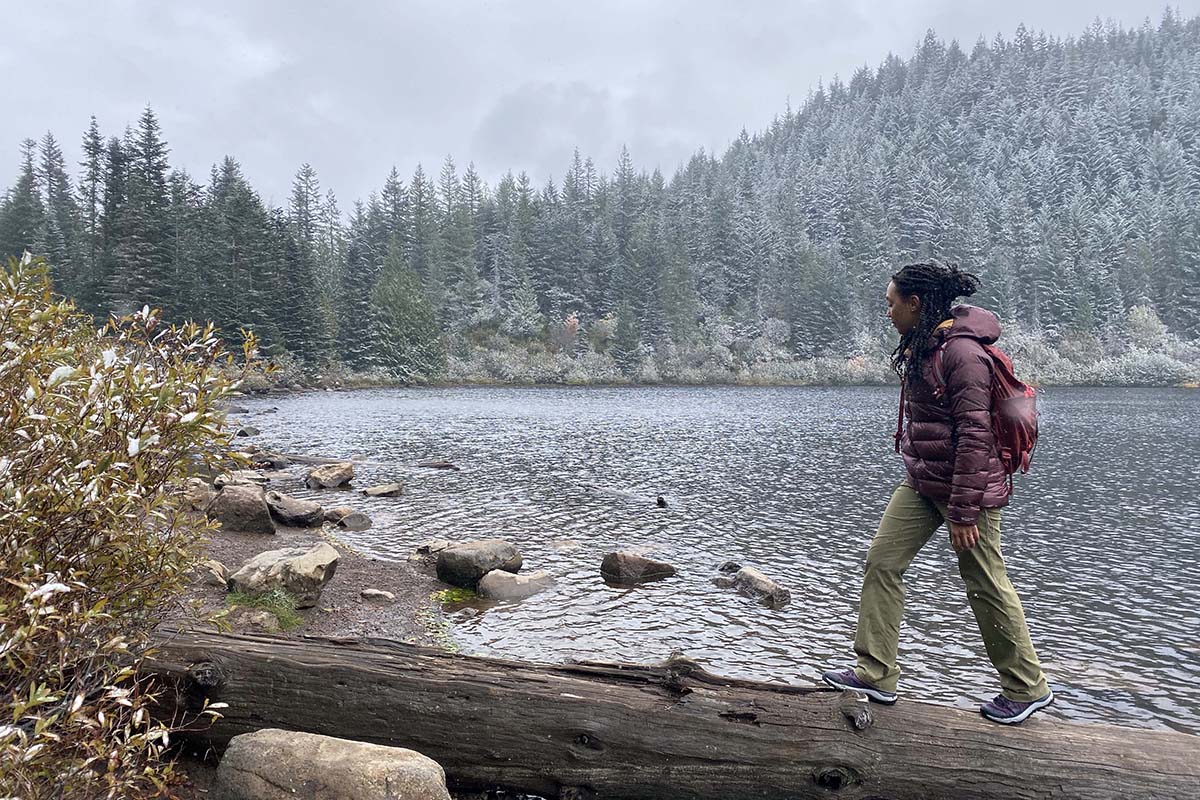
Another way that gear manufacturers fight moisture is a DWR (durable water repellant) treatment on the outside on the jacket. This treatment helps prevent water droplets from forming and entering your jacket—essentially the water has a harder time staying on the fabric and beads up and rolls off instead. Neither a DWR finish nor hydrophobic down will keep your down completely dry, but they make nice lines of defense against light to moderate precipitation.
Fit is jacket-specific, but there are two main considerations here. First, down sweaters have a more casual fit than ultralight or performance jackets, including boxier torsos, arms, and hoods (when available). Fit also varies significantly by brand. From our experience, Arc’teryx jackets like the Cerium Hoody fit the slimmest of all, which we refer to simply as the “Arc’teryx fit.” Guides and ultra-athletic folks who frequently use the gear are a key contingent for Arc’teryx, which helps explain the fit. We also like the athletic cuts on layers from Mountain Equipment and Rab. Brands like Patagonia, Outdoor Research, and Mountain Hardwear often have more accommodating shapes that balance everyday comfort with performance. And finally, we’ve found that REI Co-op and Marmot fall on the roomier end of the spectrum, and we occasionally need to size down (including with our REI 650 Down Jacket).
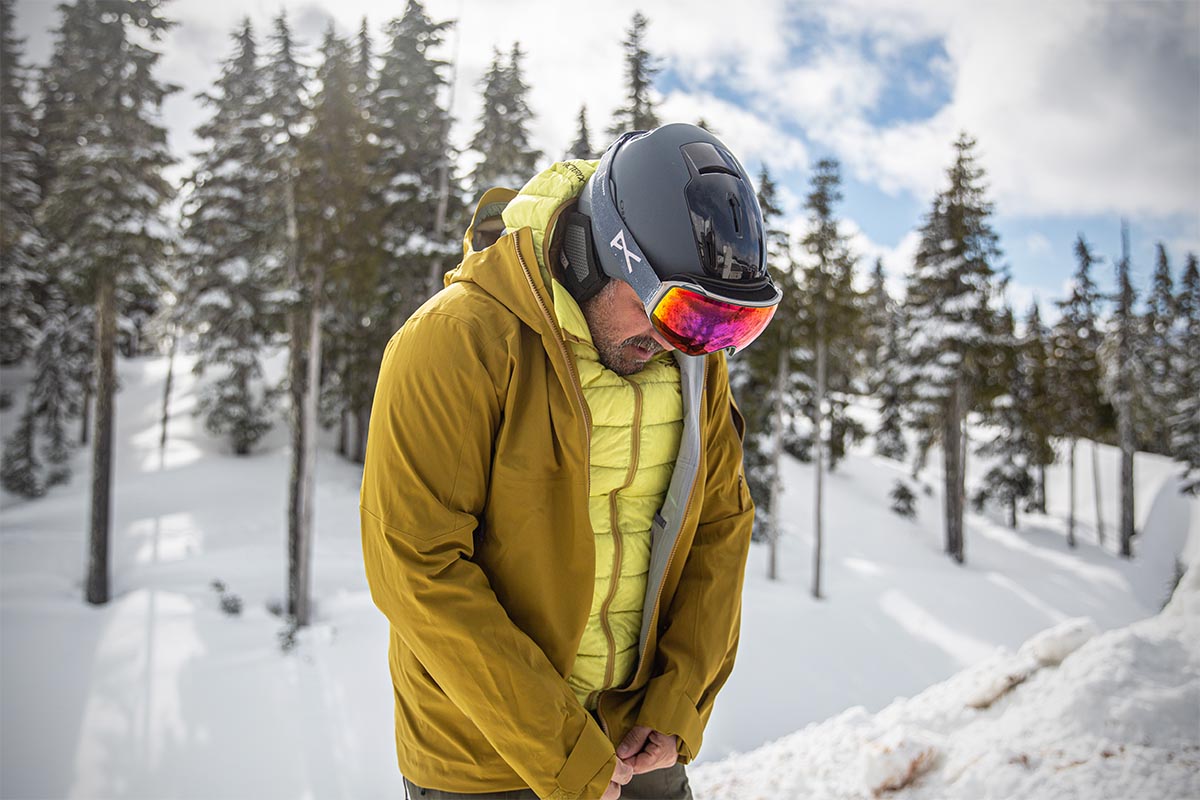
Most down jackets on this list are offered in hooded and non-hooded versions. The non-hooded version is slightly cheaper and weighs less, but you don’t get the advantage of the extra warmth and comfort. For casual use or as a midlayer for skiing, many people opt for a down vest or go without the hood and carry a separate beanie instead. For backpacking and climbing, many people get the hood and don’t regret it. You’ll notice that in our picks above, we listed down sweaters in the non-hooded versions (when available), which are the most commonly purchased, and the ultralights with hoods, also the most common for that variety of jacket. For a deeper dive into the topic, see our article: Does Your Down Jacket Need a Hood?
This article is unisex in nature and we have both men and women gear testers getting outdoors in all seasons and types of conditions (and you’ll notice that whenever possible, product buttons are provided for both the men’s and women’s versions). In addition, we have created a round-up of the best women’s-specific down jackets covering that category in particular. Many of the models are the same but the names and colorways sometimes vary. On occasion, a specific design feature or the fit will differ. And there are products that are only available for women or vice versa. Regardless, we hope that it’s helpful for those who prefer to see how the women's-specific designs stack up.
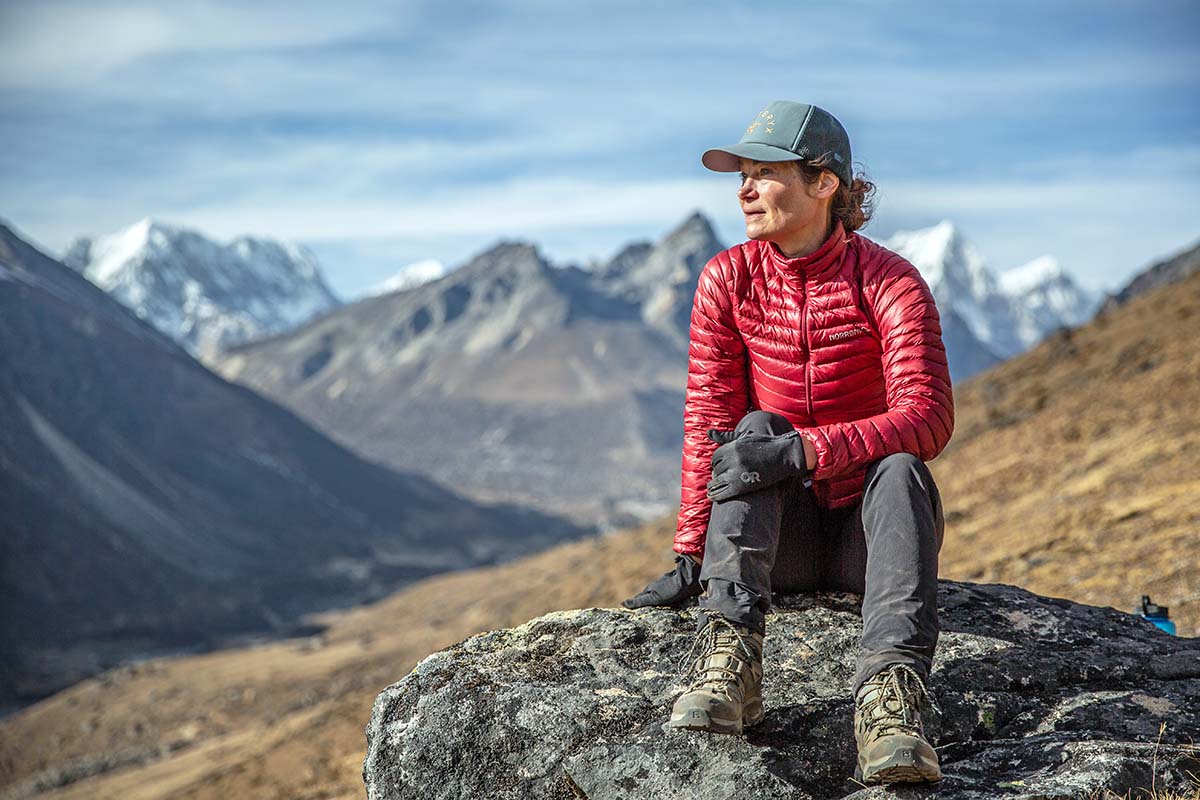
Our impact on the environment has never been of greater concern, and it’s nice to see gear companies step it up with more sustainable practices. One measure we’re seeing more and more of is the use of responsibly sourced down (look for an RDS certification). In short, this translates to greater transparency in where the down comes from and ensures the birds were treated humanely and not subjected to unnecessary harm, such as force-feeding or live-plucking. In addition, the use of recycled fabrics has grown substantially in the past few years, with companies like Patagonia, REI Co-op, and Mountain Hardwear prioritizing these materials.
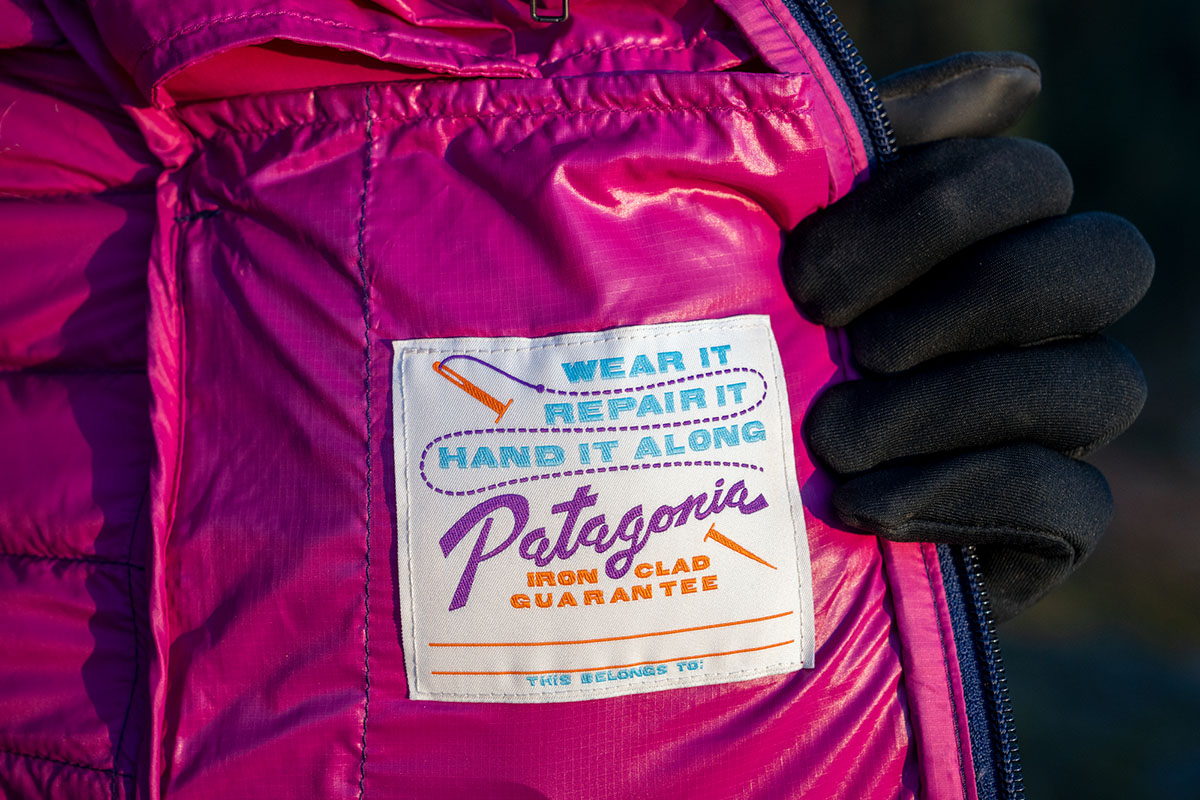
A final trend to touch on is the use of PFC-free durable water repellent (DWR) finishes. We detail the benefits of DWR above, but pertaining to sustainability, traditional DWR coatings use per- or polyfluorinated chemicals—"forever chemicals" known to be harmful to the environment. With many states stepping up to ban the sale of items that include PFCs, the outdoor industry is seeking better solutions for water- and stain-resistant finishes (for more, you can read about Patagonia’s take on the issue). The good news is that many brands have started making the shift to PFC-free DWRs, including Stio, Black Diamond, and Patagonia.
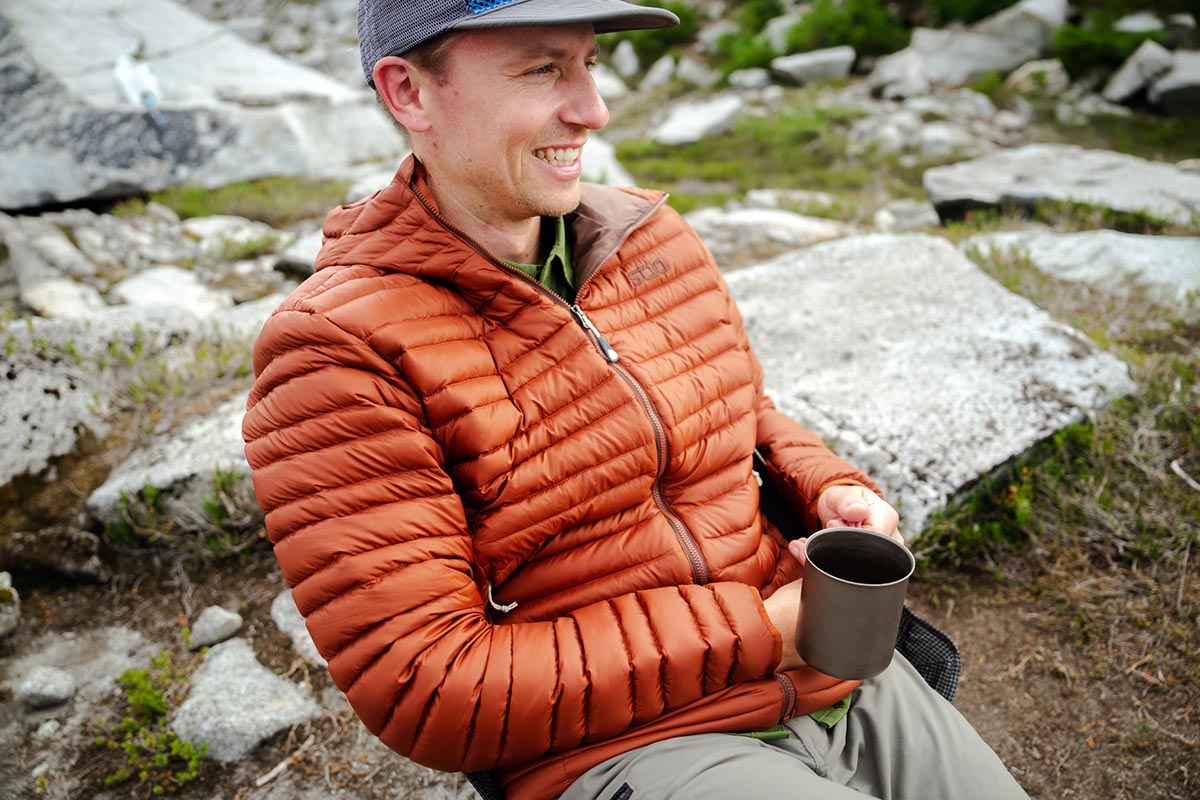
There is a lot to be said for synthetic insulated jackets, which insulate better than down when wet, are more breathable, and cheaper. However, down still has no replacement (at least for now). The warmth-to-weight ratio is unparalleled, as are compressibility and comfort. We’ve tested a number of synthetic jackets like the Arc’teryx Atom LT and Patagonia Micro Puff, both are which are very comfortable and reasonably light, but the warmth just isn’t the same. We often reach for synthetics for everyday use and light outdoor activities in the fall and spring, but they take up too much space in our packs for extended backcountry trips and most don’t provide quite enough warmth for truly cold days. Optimally you would have both, but if you’re only in the market for a single jacket, there’s simply no better insulator than down. For a more detailed explanation of this topic, see our article on down vs. synthetic insulation.
Back to Our Top Down Jacket Picks Back to Our Down Jacket Comparison Table